On Monday the 19th, we headed north from Nanaimo, intending to be in Campbell River on Tuesday, stopping for the night in Ford Cove on Hornby Island. This was easily our most uncomfortable passage yet–we were able to sail most of the way, with 15-20 knots of wind on our starboard quarter, but while we were able to sail, the motion of the waves in the Strait of Georgia hitting us in the same starboard quarter made for a very uncomfortable ride. I got mildly nauseous, and my partner got a bit worse than that, feeling fairly seasick for the first two hours.
Thankfully, Ford Cove gave us good protection from the wind and waves overnight and we slept well, and the next day was as calm as could be, a welcome relief from the previous day. However, we’d been having issues with the furling main getting stuck trying to unfurl, so while we motored north (thinking we’d get to Campbell River), I made some calls until I found a rigger that could help us out; the rigger (Blanchard Rigging) was based out of Comox and said they could come see us that afternoon if we just went directly to the Comox Valley Harbour Authority docks, so we did.
True to their word, right after lunch they showed up and helped us out. Turns out it wasn’t actually the sail getting bunched up, it was the furling gear itself. To prevent issues from getting it back out and down, we pulled down and folded up the mains’l and put it in the guest cabin. Of course, one of the only things I’d forgotten to get maintained while we were back in Seattle! Looks like nobody had ever done any maintenance on it either. So, while they didn’t have time to deal with it that day (but they did help us take the mains’l down entirely, and it’s sitting folded up in the guest cabin right now), they said they’d be able to do the work the following week, and recommended we just head up to Desolation Sound for the rest of the week and weekend. While in Comox I was also able to get the final parts to hook up a bidet attachment to one of our heads. This will (among other things!) help us use far less toilet paper.
(note: pictures with timestamps on them are taken by my partner on her phone and provided to me for this blog)
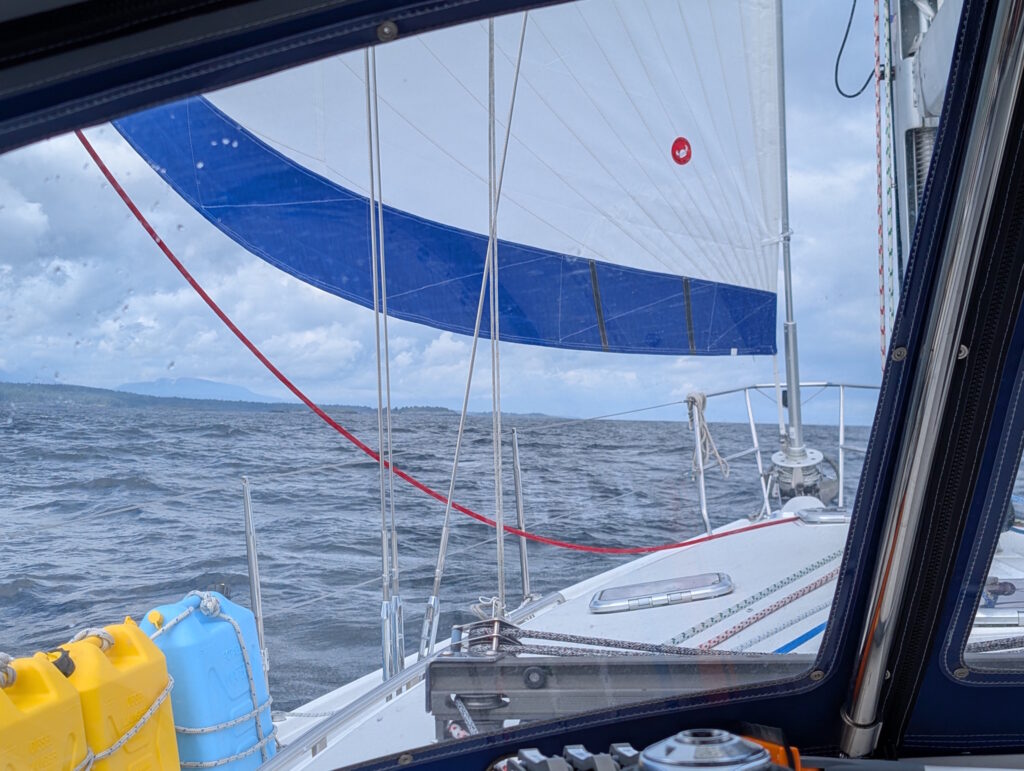
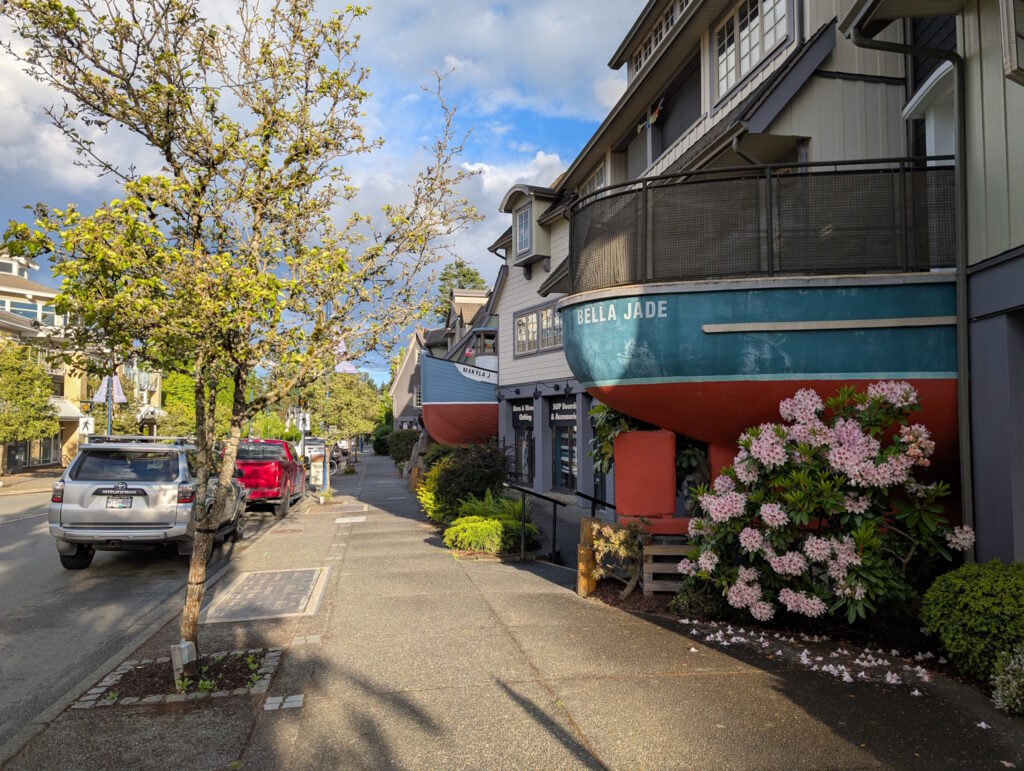
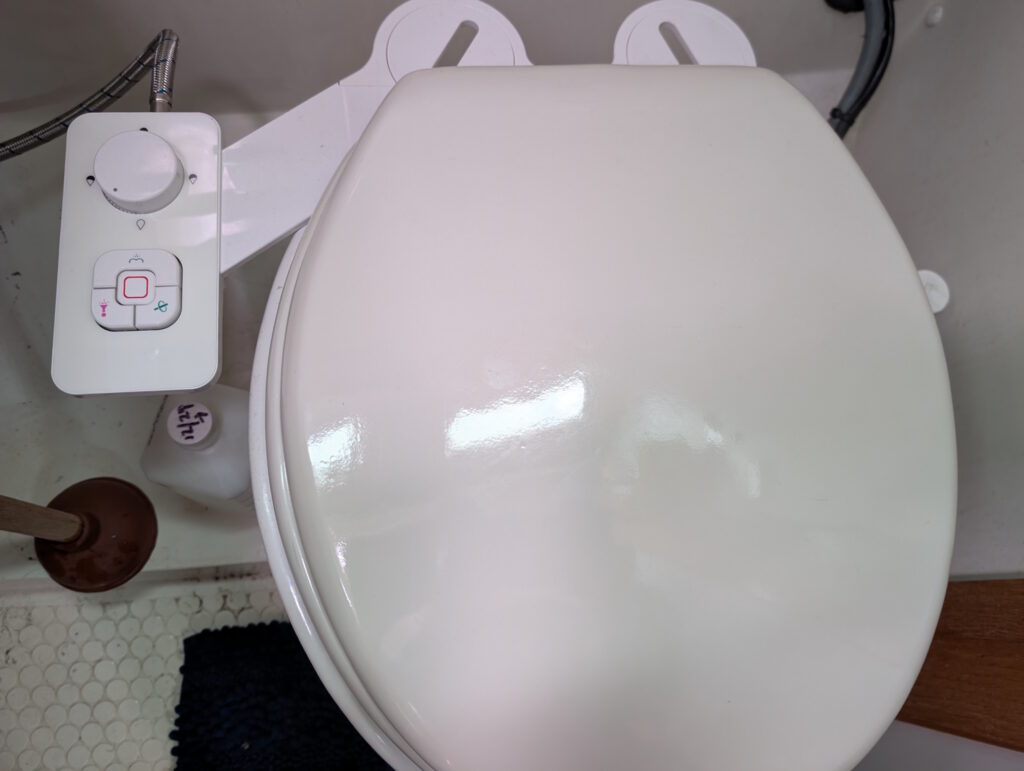
Making our way towards Desolation Sound: Gorge Harbour
Thus, we didn’t end up going to Campbell River. Instead, the following day, we motored (again in extremely calm weather) up to Cortes Island into the beautiful, calm Gorge Harbour. This is easily the most unique, protected harbor I’ve ever seen, as you can see from the satellite image here:
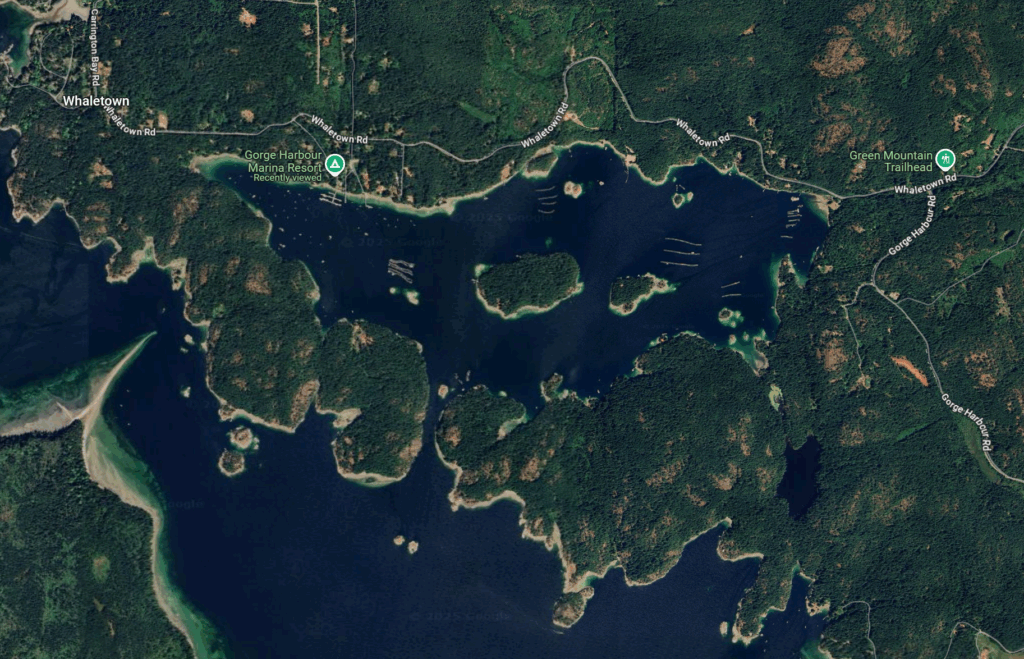
Yes, we enter through that very narrow channel on the south end, and once inside, there are a number of shellfish farms, with the main anchorage (plus the marina-resort) on the west end. Needless to say, it is incredibly calm and quiet in there.
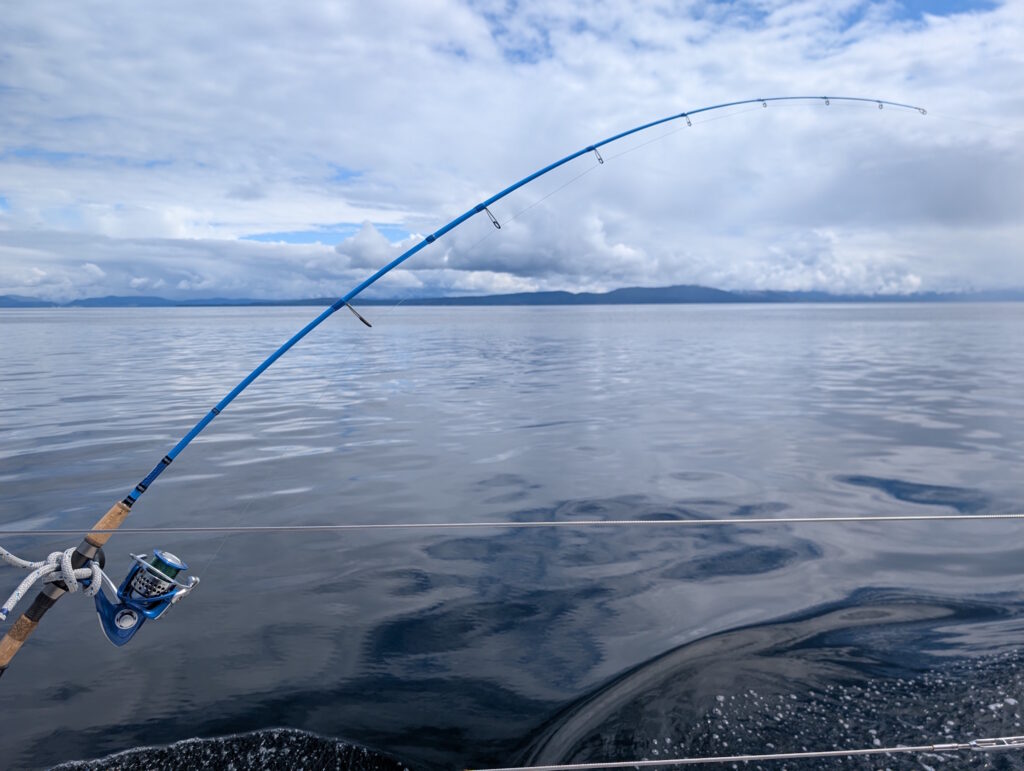
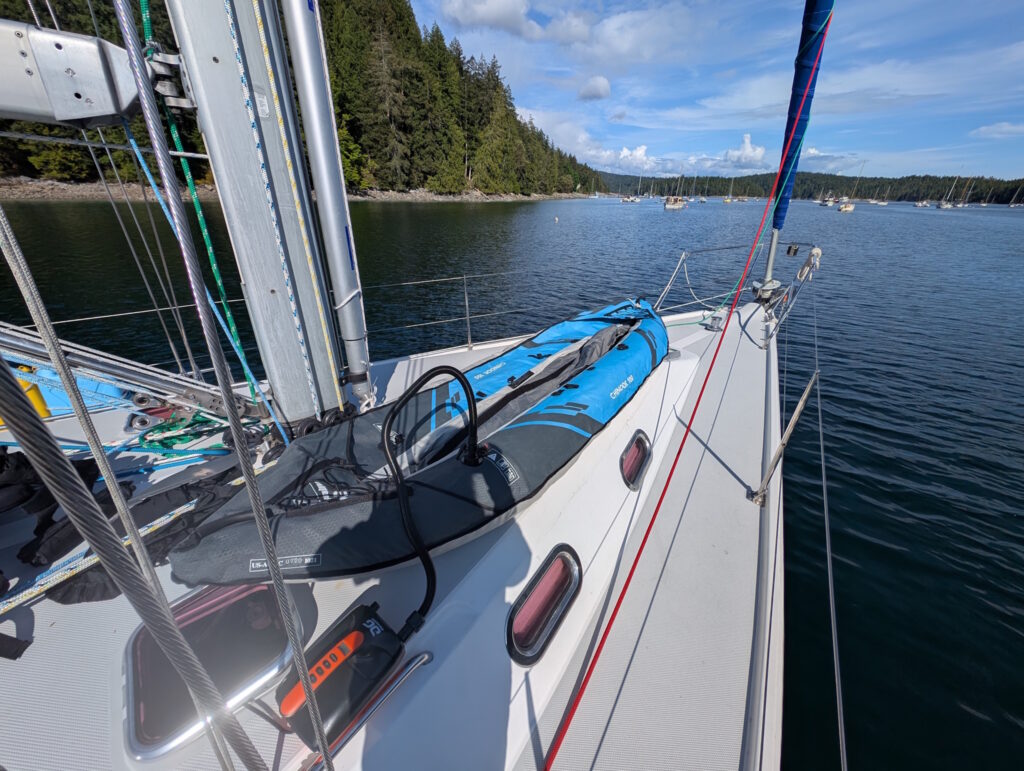
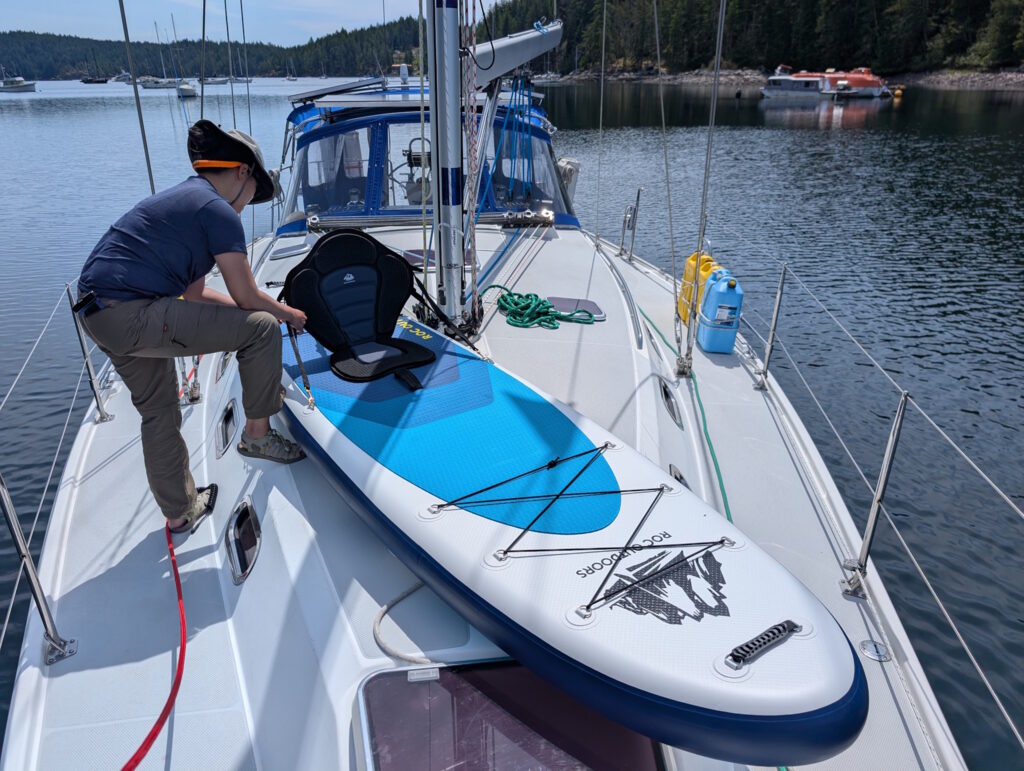
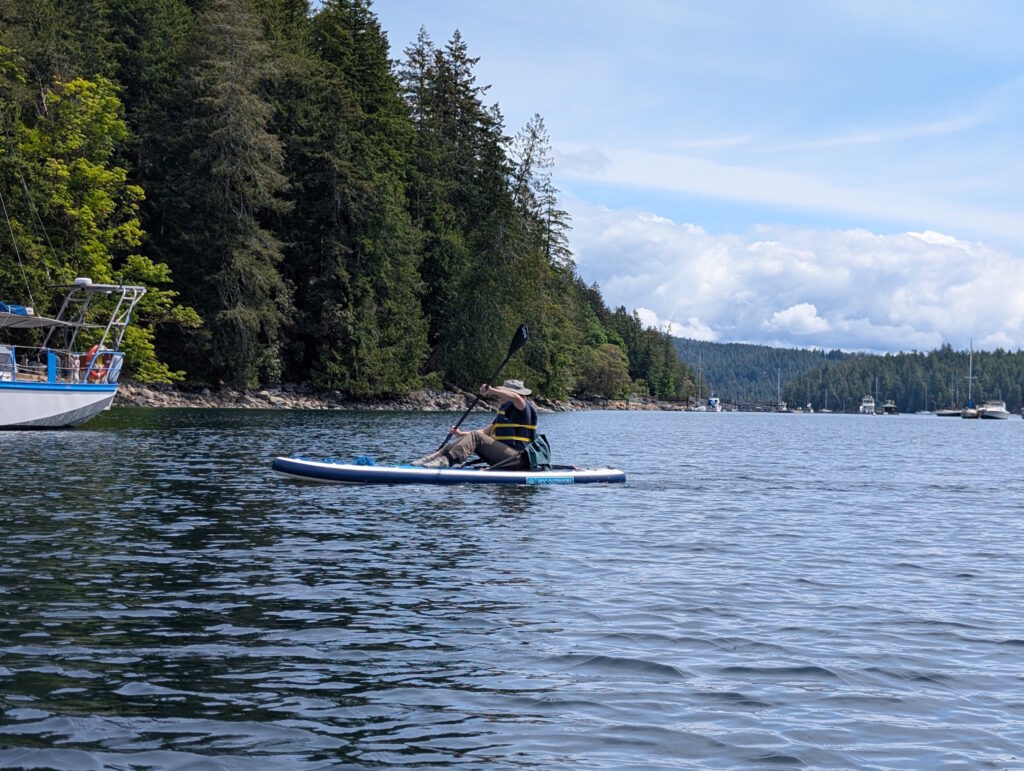
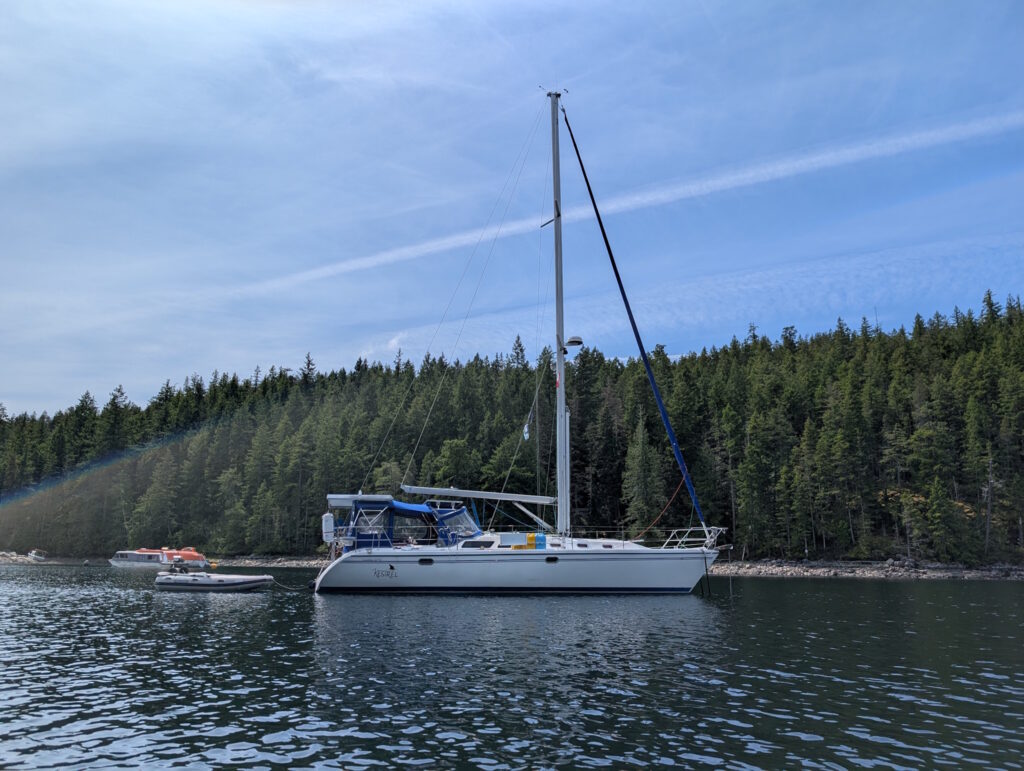
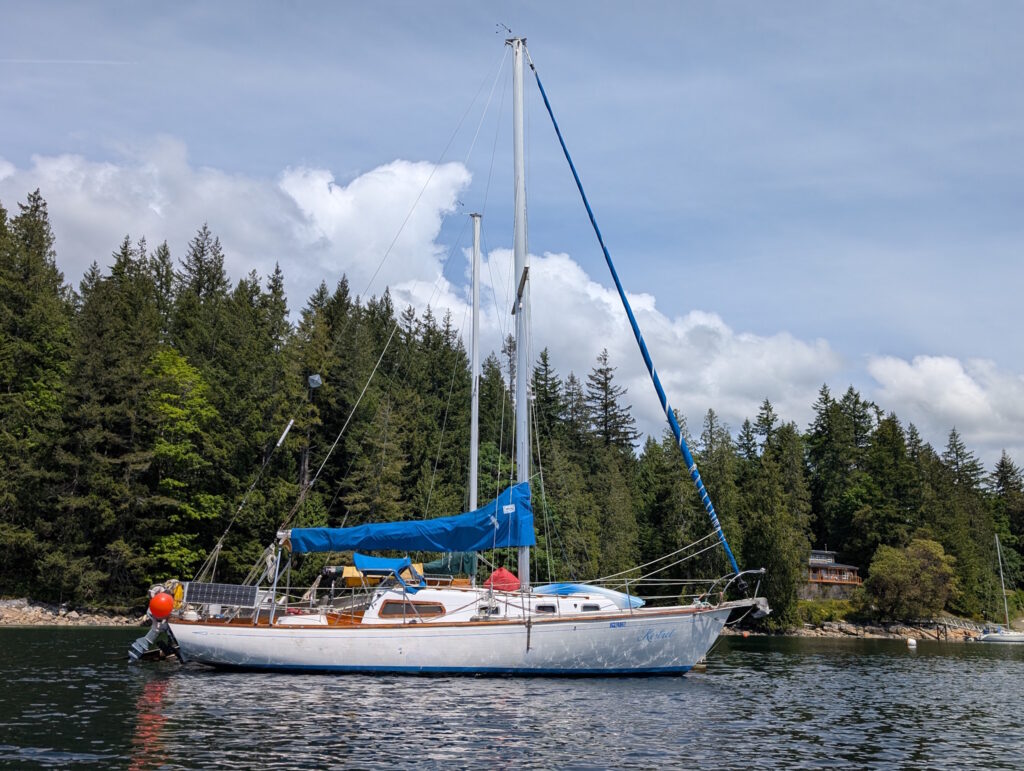
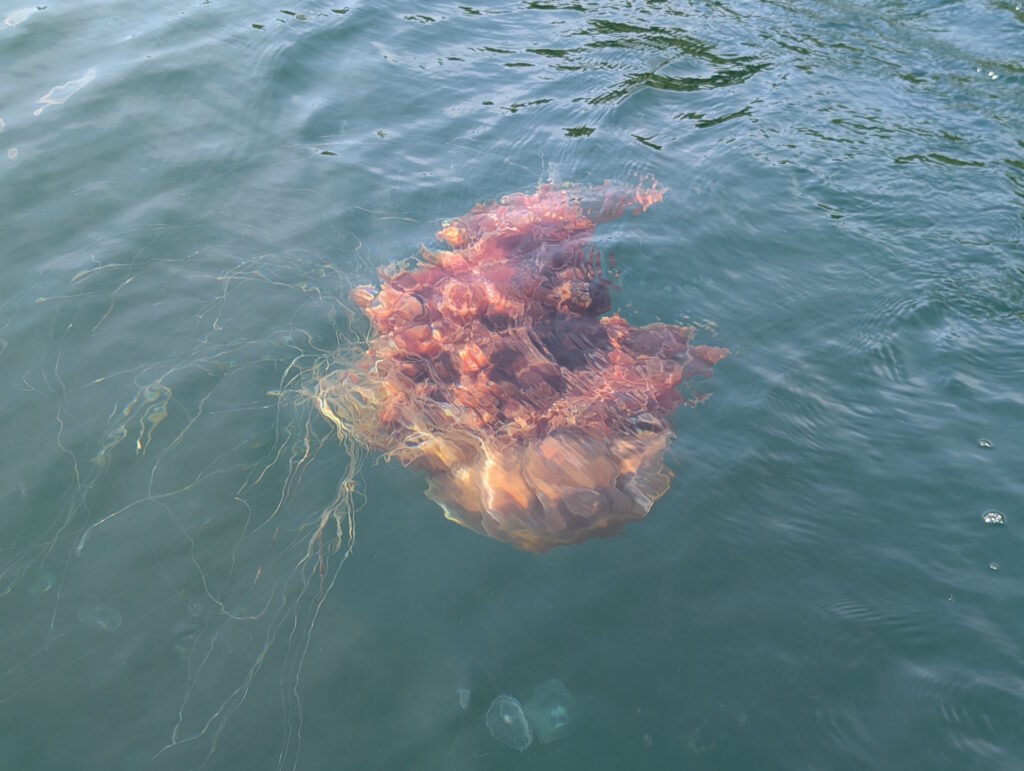
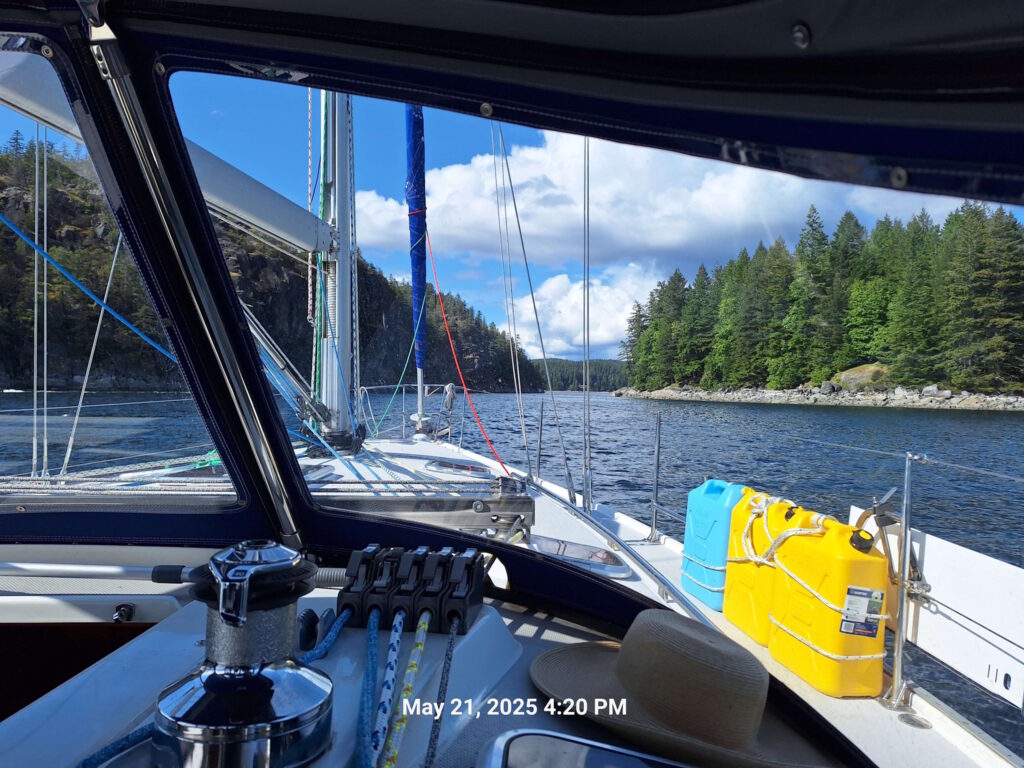
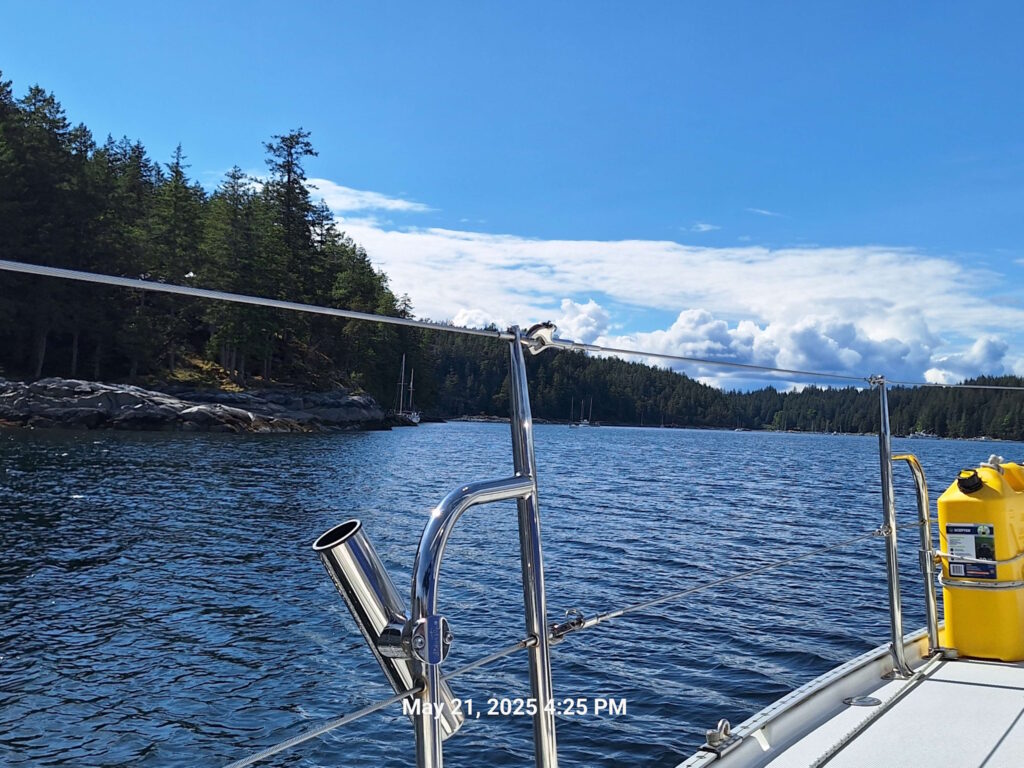
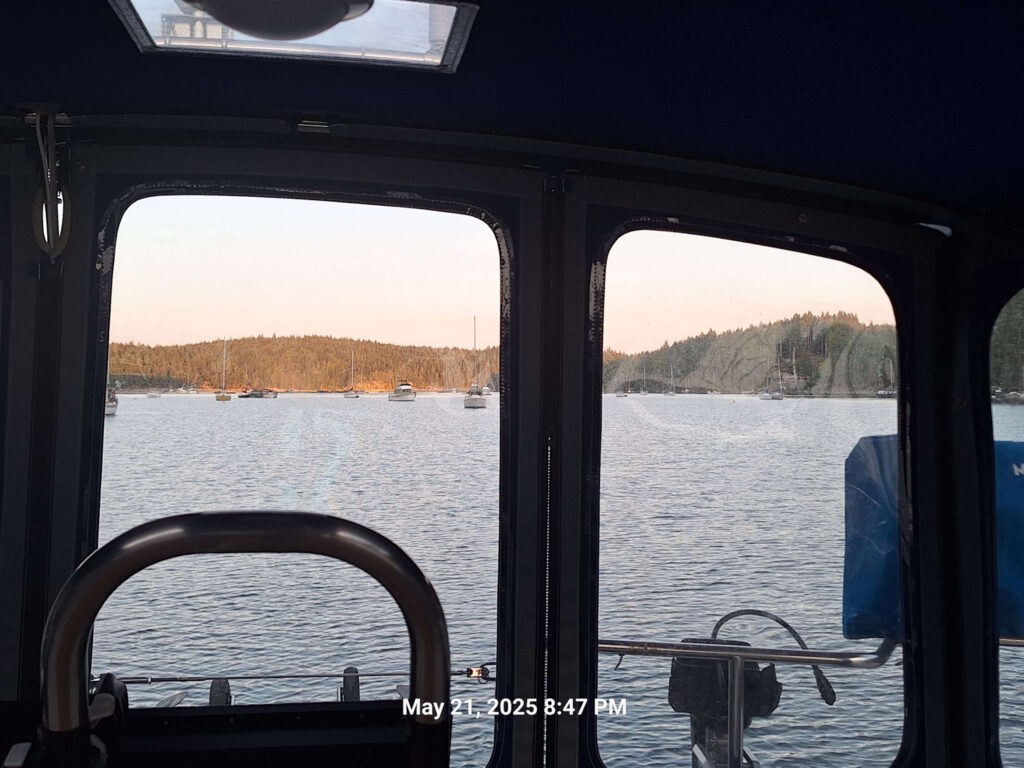
The weather was so lovely, it was so quiet and calm, and we had reasonably high-speed 4G/sometimes 5G internet, that we stayed for three nights. My partner had her first opportunity to inflate the stand-up paddleboard I’d gotten for her birthday, one with an optional seat and a paddle with swappable ends for changing between SUP-mode and kayak mode. I inflated my trusty inflatable kayak, and we had a very nice time paddling around the west end of the harbor. A very good place for a first SUP experience, too, since it was nearly dead-calm all day every day while we were there.
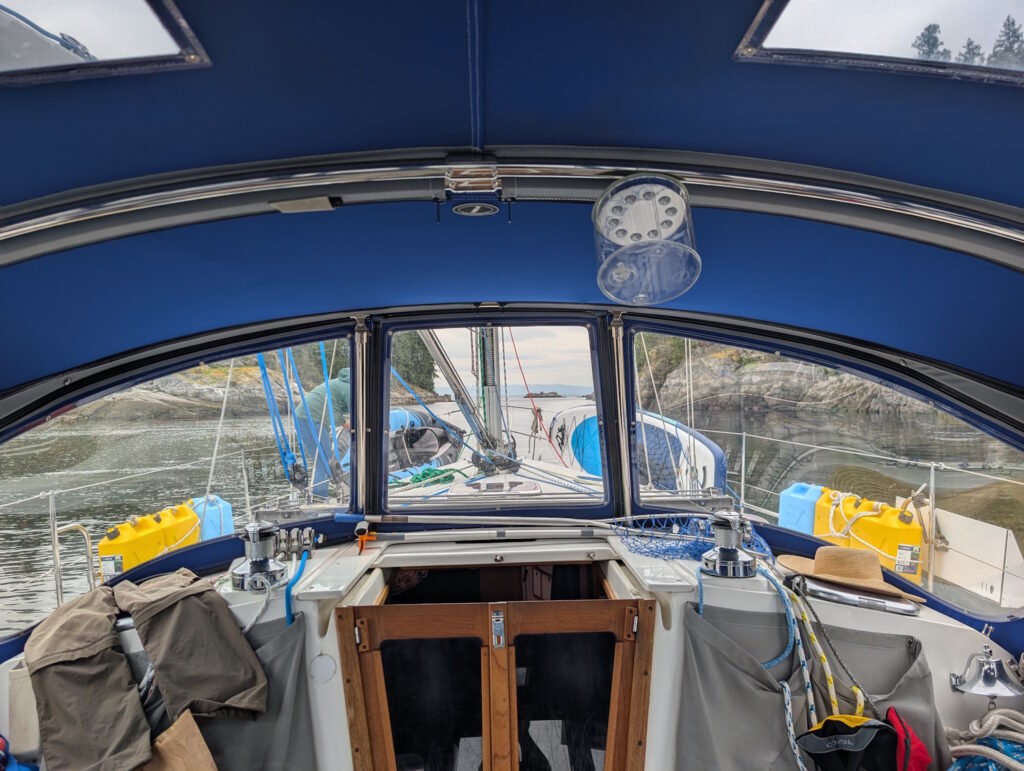
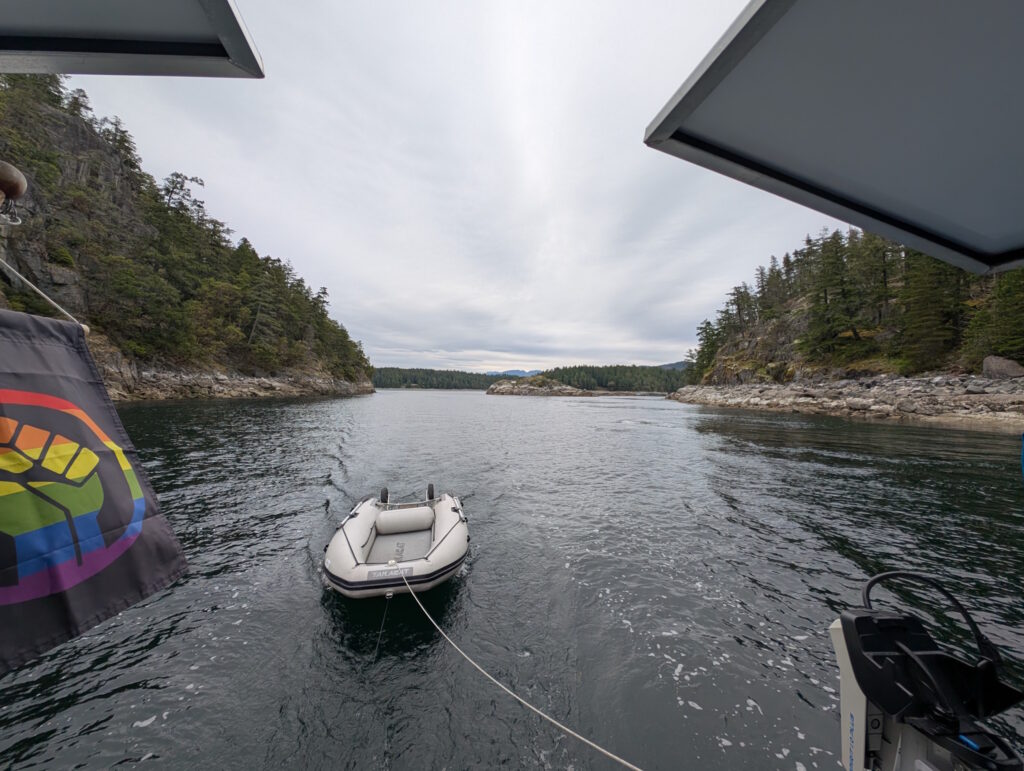
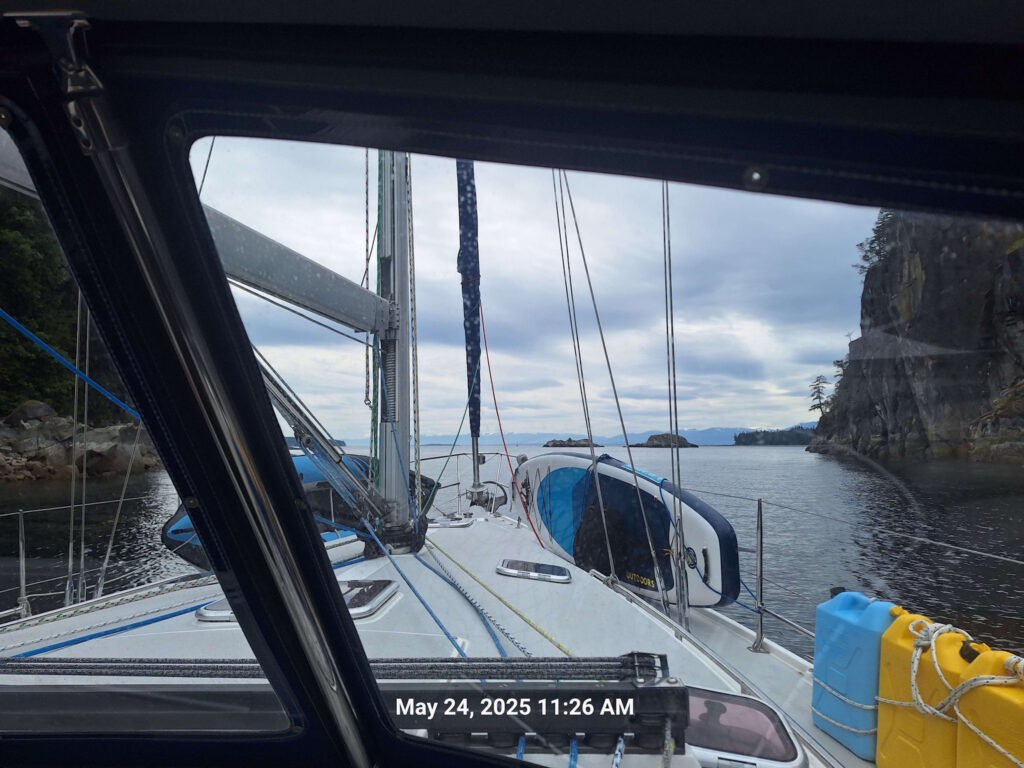
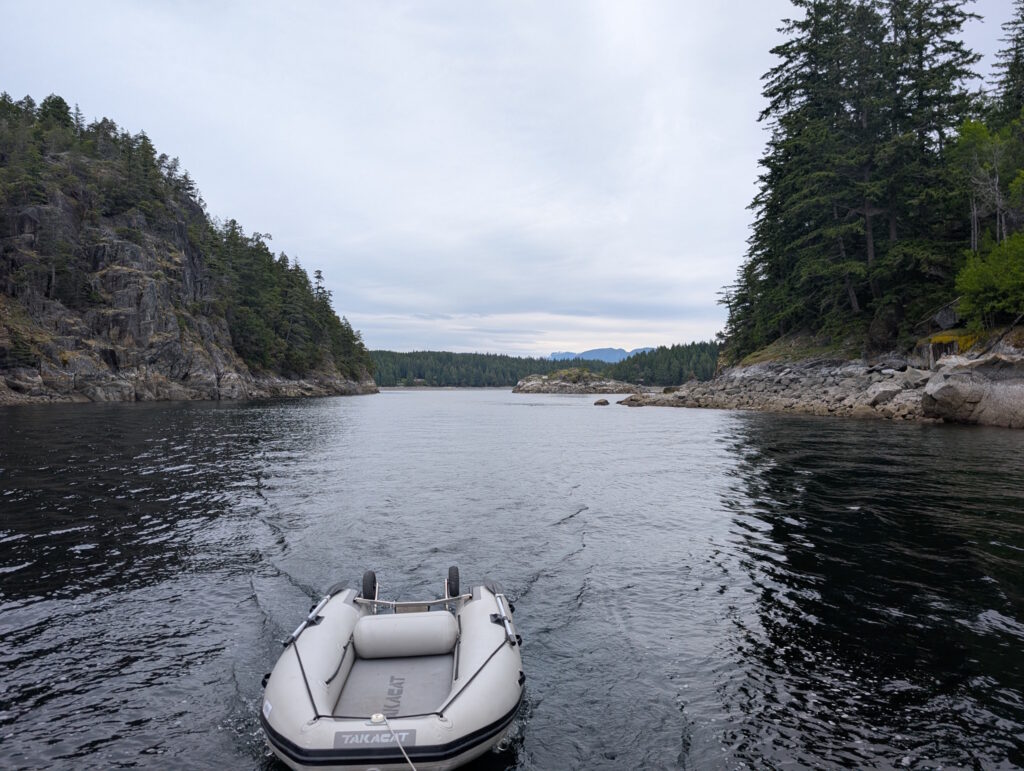
Desolation Sound
On Saturday we motored (with a touch of motor-sailing when there was any wind) east to a tiny cove on the north-east end of Desolation Sound. Laura Cove is, I am pretty certain, the smallest place we’ve ever anchored. In the eastern end of the cove we anchored in about 35 feet (at around high tide) of water in as close as we could guess was the middle of the area and then made our first-ever stern tying attempt. A messy, yet successful attempt, at least! With 300 feet of floating line, I tied us to a very large mostly-sunken log nestled among big rocks. In the place we were there were, unfortunately, none of the chains on pitons installed as there were in the central and western part, and I learned why those are so much nicer to use because I got quite wet maneuvering wet line under a big log without causing chafe to the line.
Still, it worked, and we held still–within limits at least, there was a pretty big tidal swing of over 10 feet overnight, and part of this learning experience was that we needed to tighten them up a lot more than that in the future.
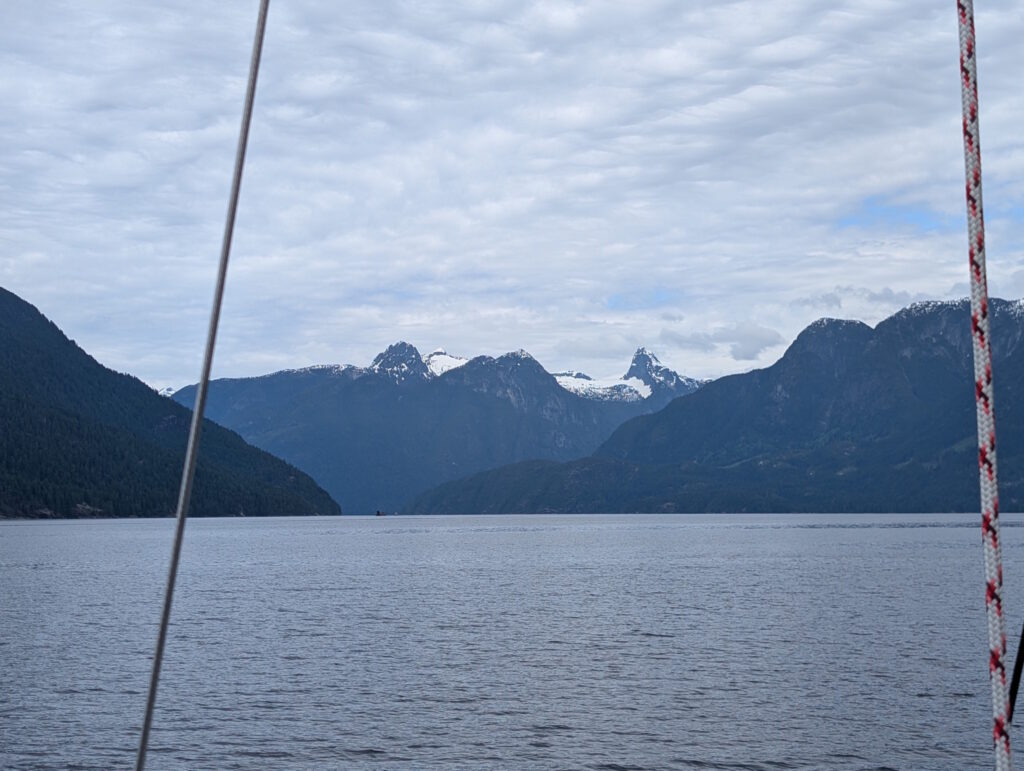
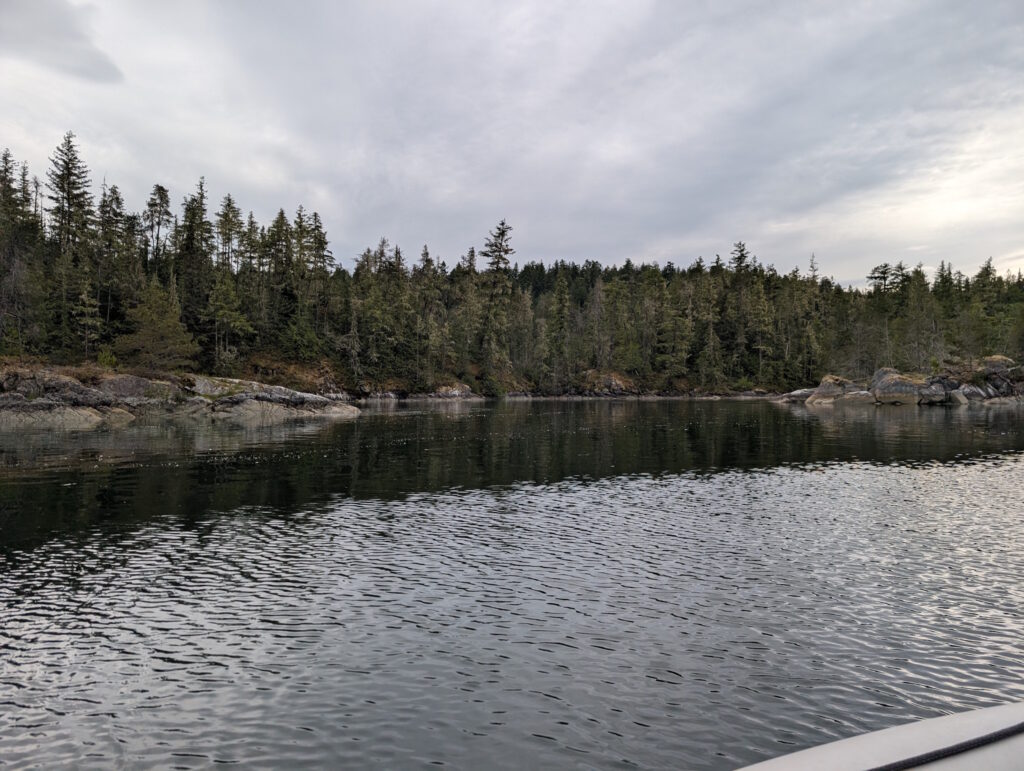
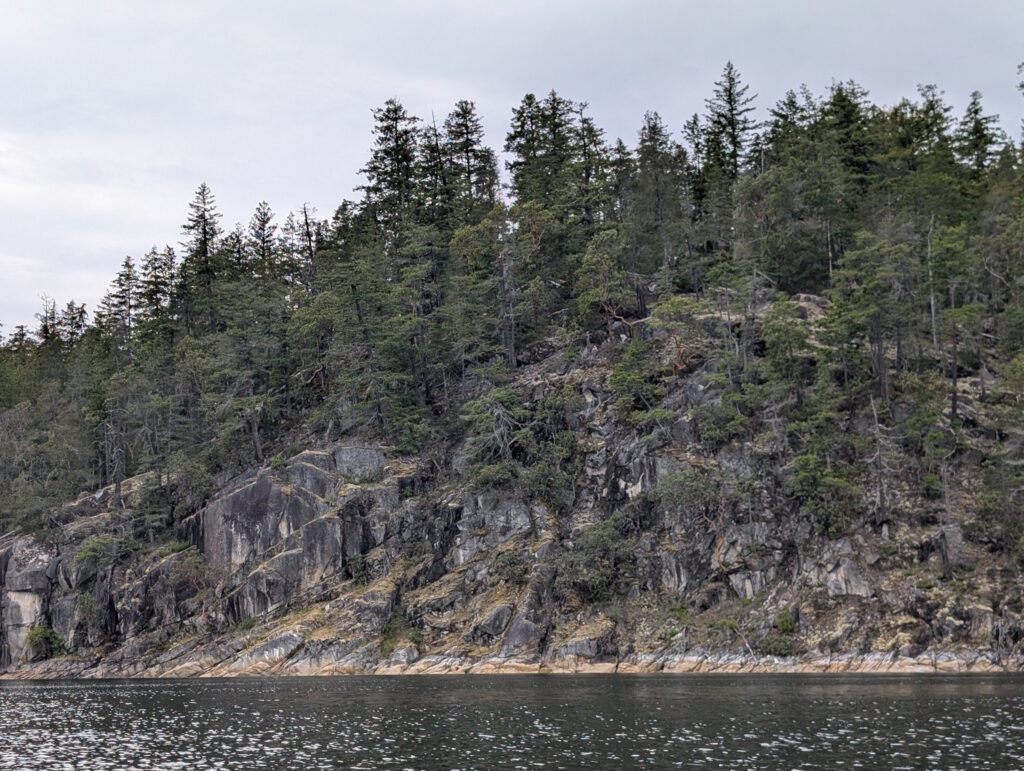
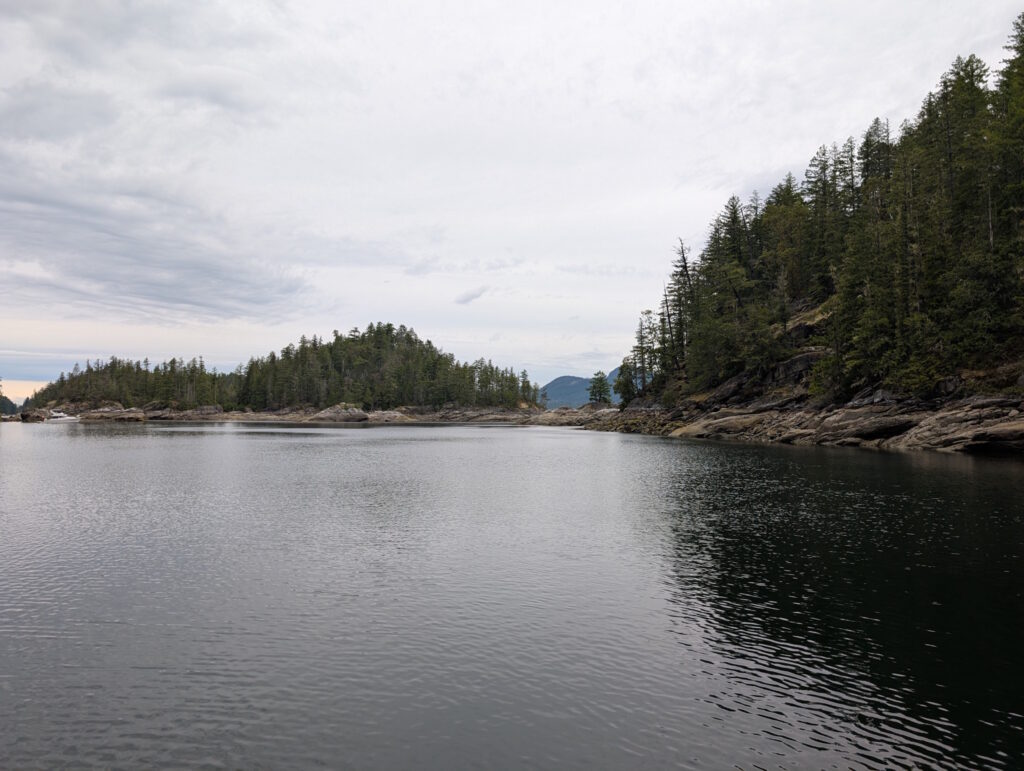
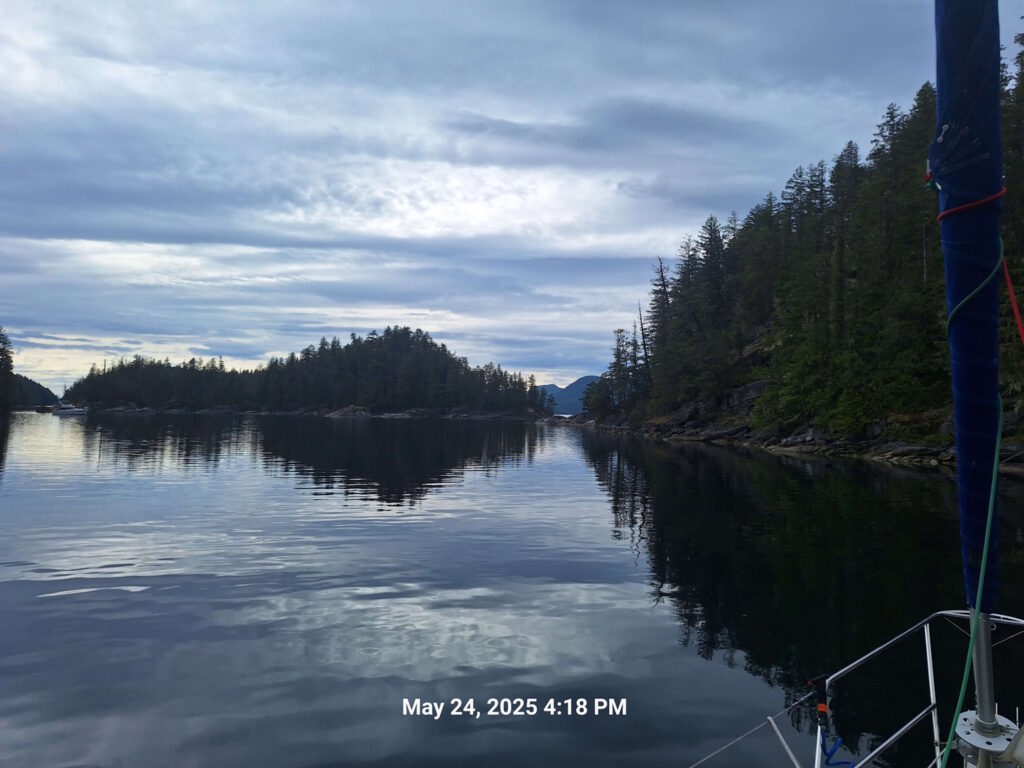
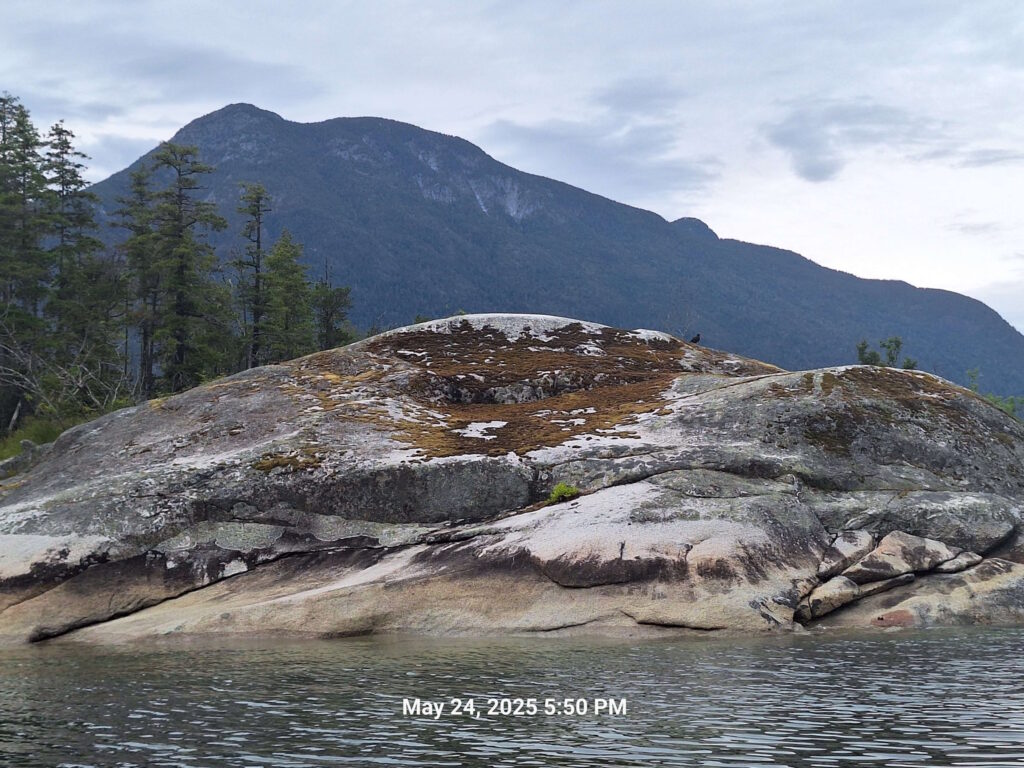
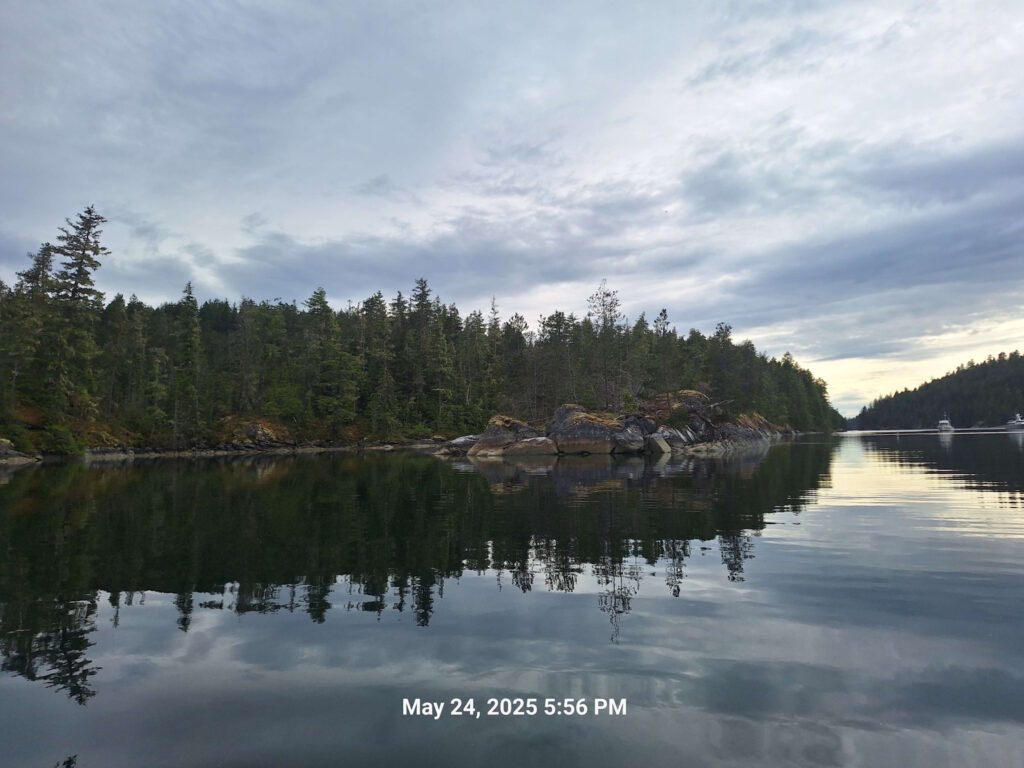
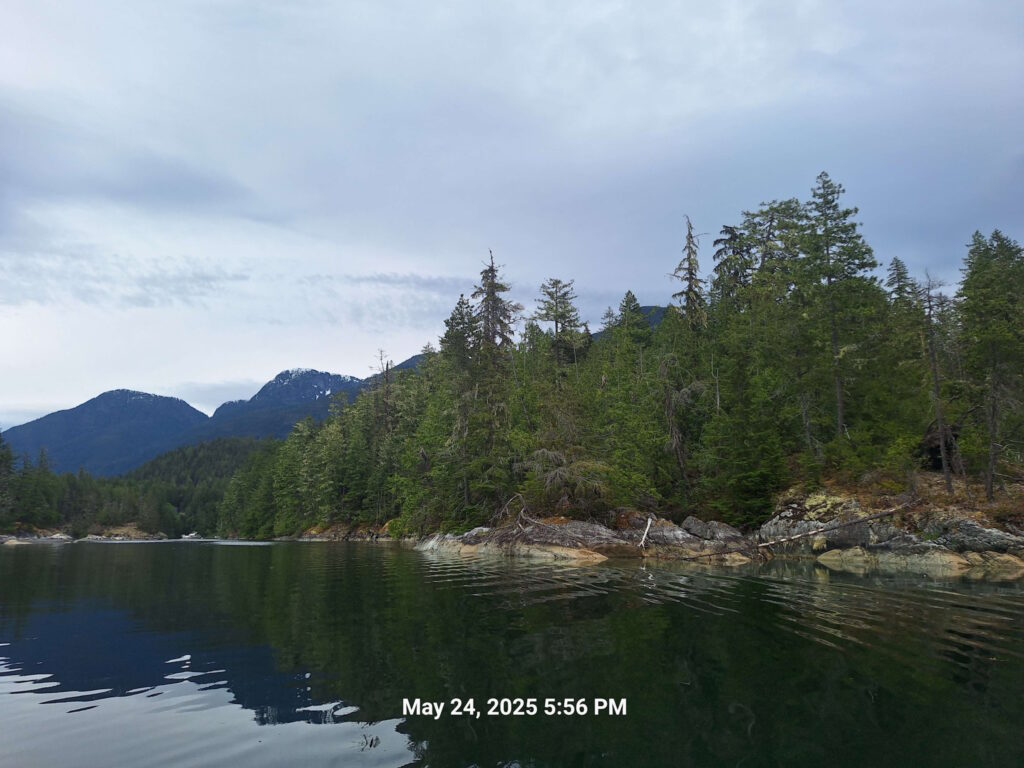
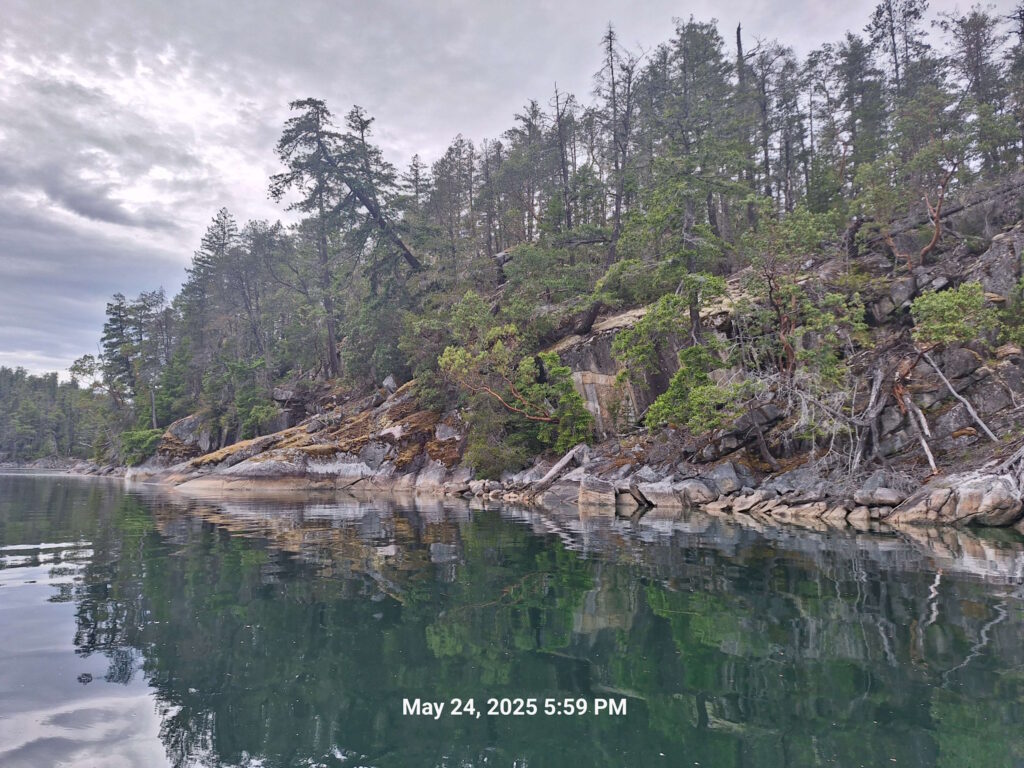
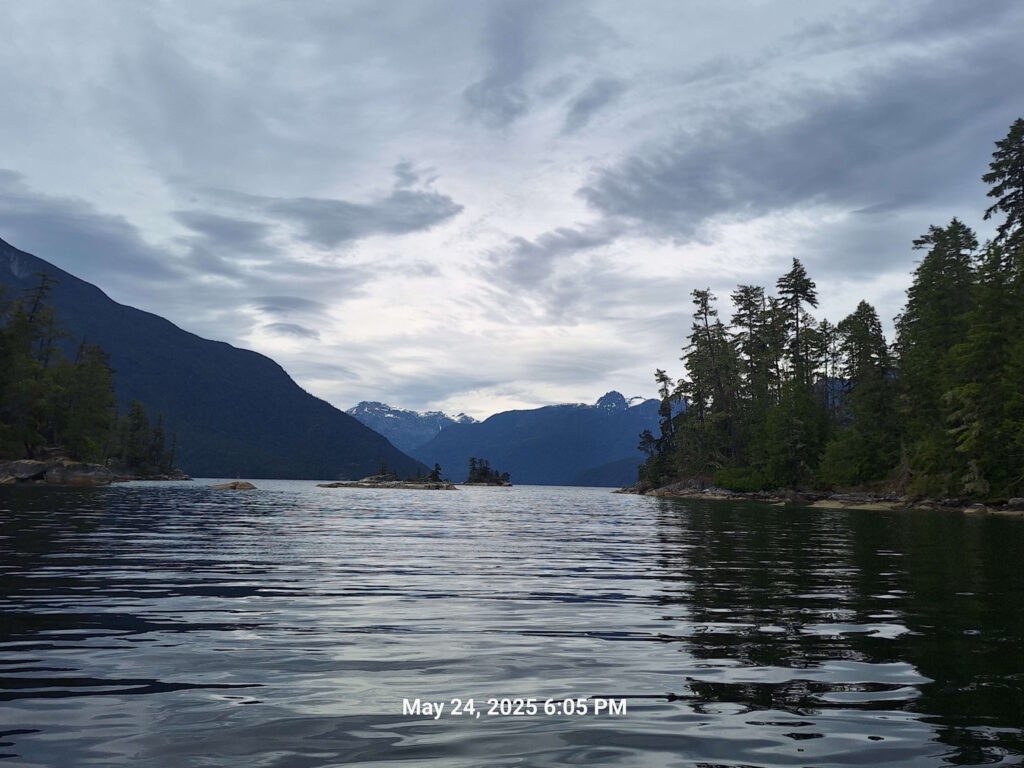
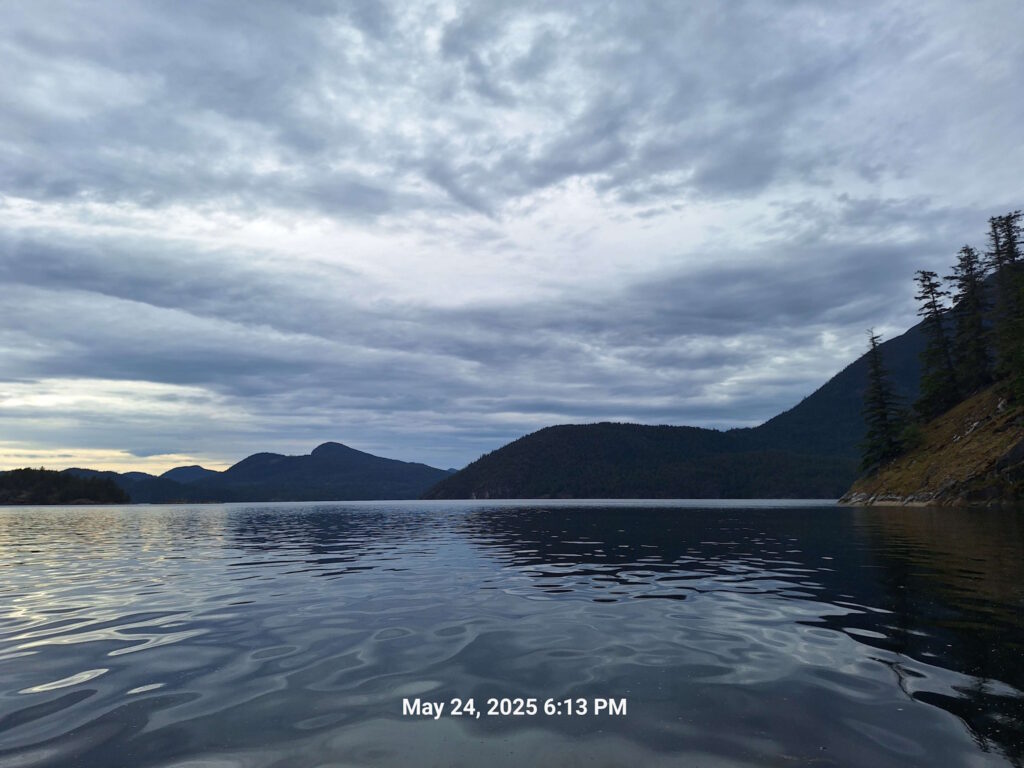
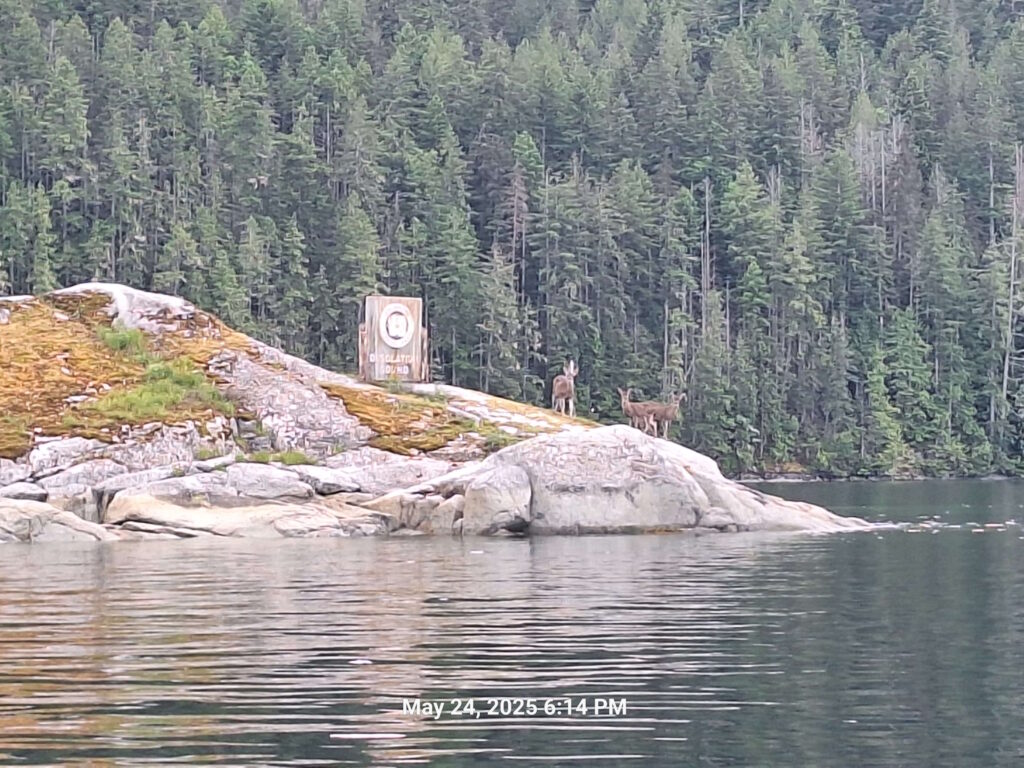
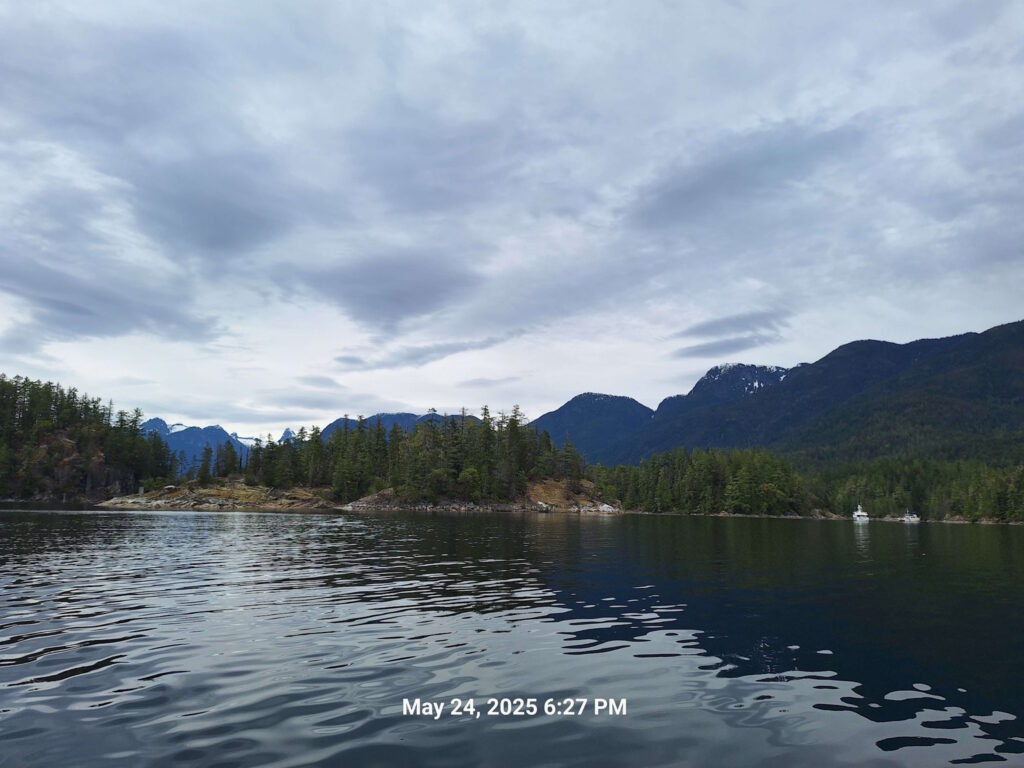
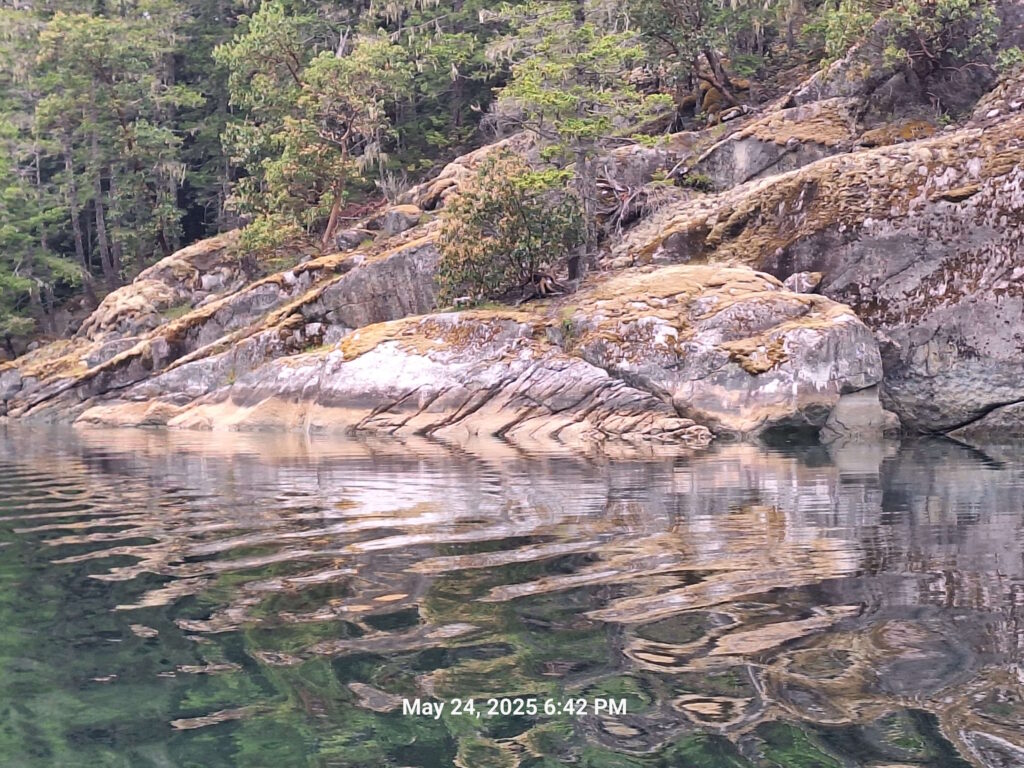

While it would have been nice to have stayed there longer, between the mediocre stern-tie job and the desire to be able to easily contact the rigger about timing, we moved over a short hop west to the neighboring bay, Prideaux Haven. This bay and south-eastern branch, Melanie Cove, are both connected to Laura Cove with waterways around several neighboring rocky islands that exist only at mid-to-high tide. Far too shallow and rocky even at very high tide to risk Kestrel through it, and in many parts dried completely at low tides, it was fun to take the dinghy through with its quiet electric engine.
Popular, also, for the other early-season visitors to this area. Only one other boat at a time anchored (and stern-tied, better than us) in Laura Cove, while we were there, and somewhere around 10-12 in Prideaux Haven/Melanie Cove. But there were several sets of people going back and forth in various kayaks and dinghies each day. While out in the dinghy, my partner surprised herself and some deer (a doe and her partly grown fawns, from what she could tell) hanging out on the very small rocky island with the “Desolation Sound” sign at the entrance of Prideaux Haven.
In Prideaux Haven we anchored in about 50 feet of water, using 200 feet of chain (including the Mantus anchor bridle). Though there were abundant chains for stern tying on the rock walls through parts of the bay, including near us, there was no need to use it this early in the season with how few other boats were in the anchorage.

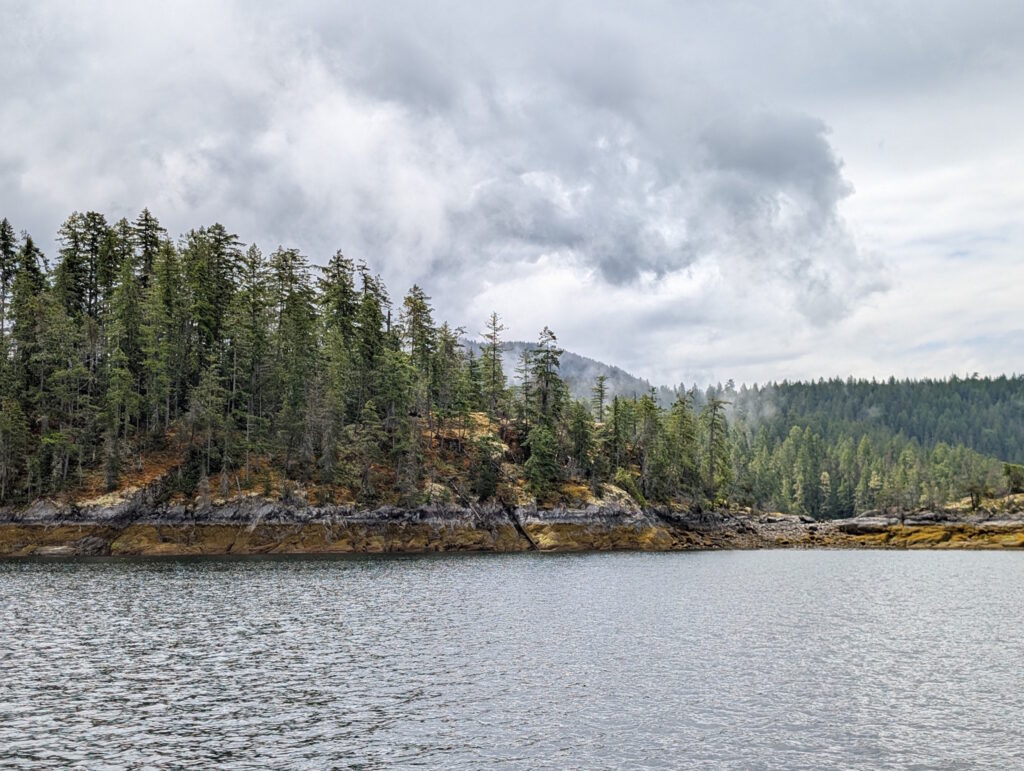
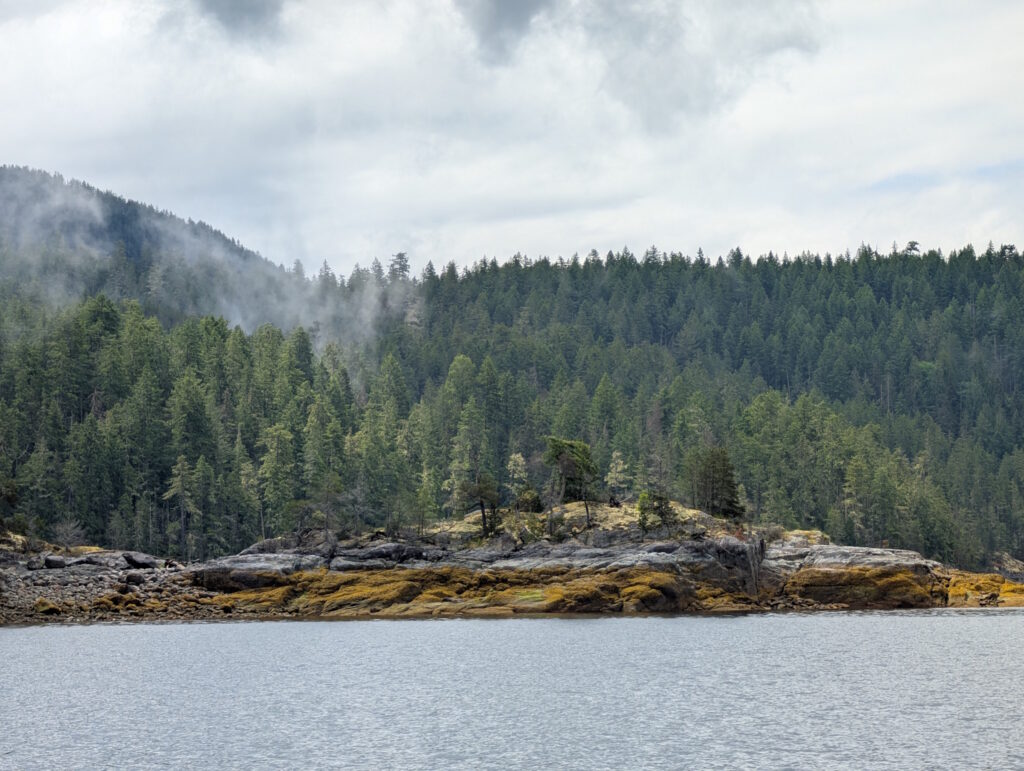
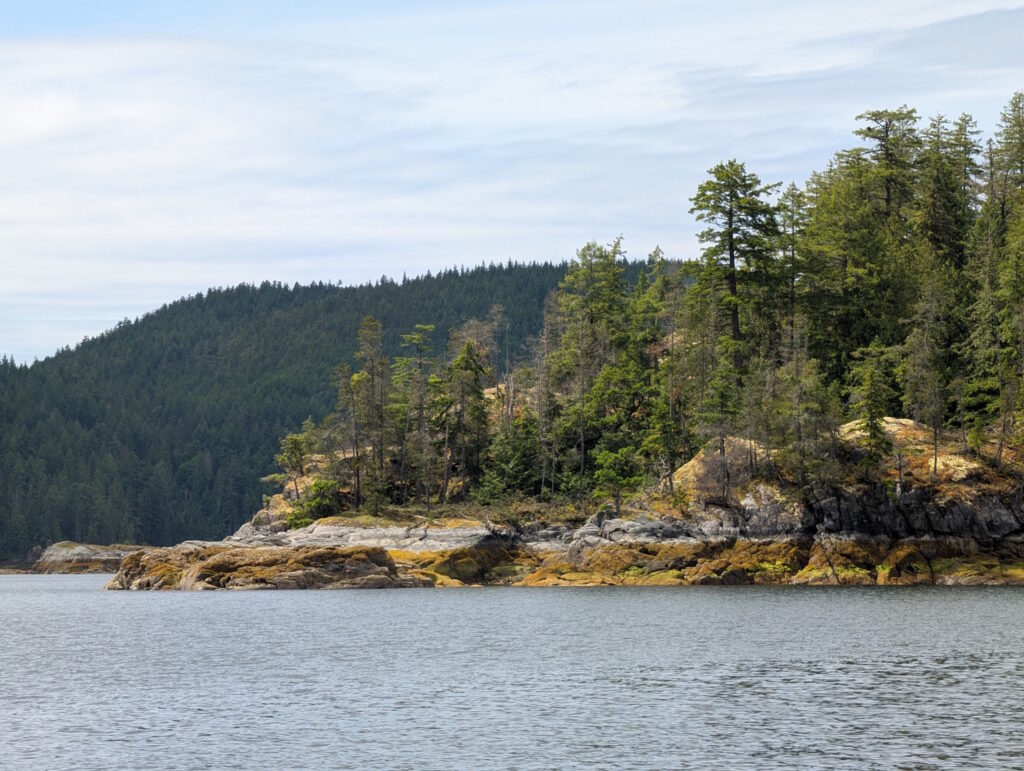
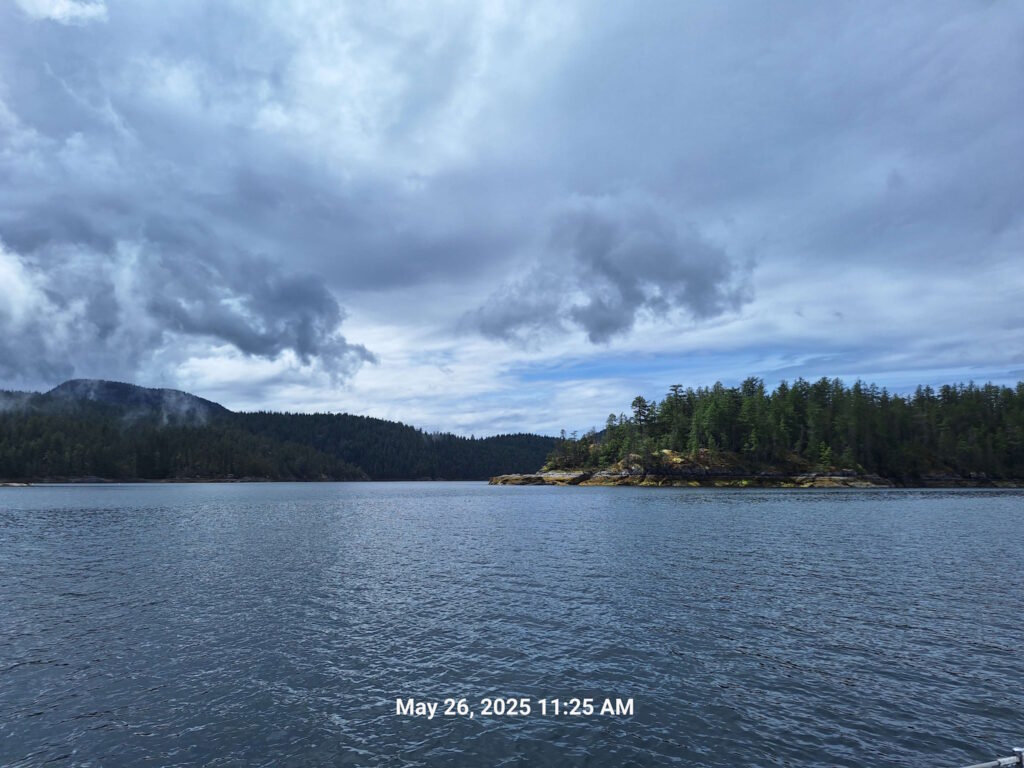
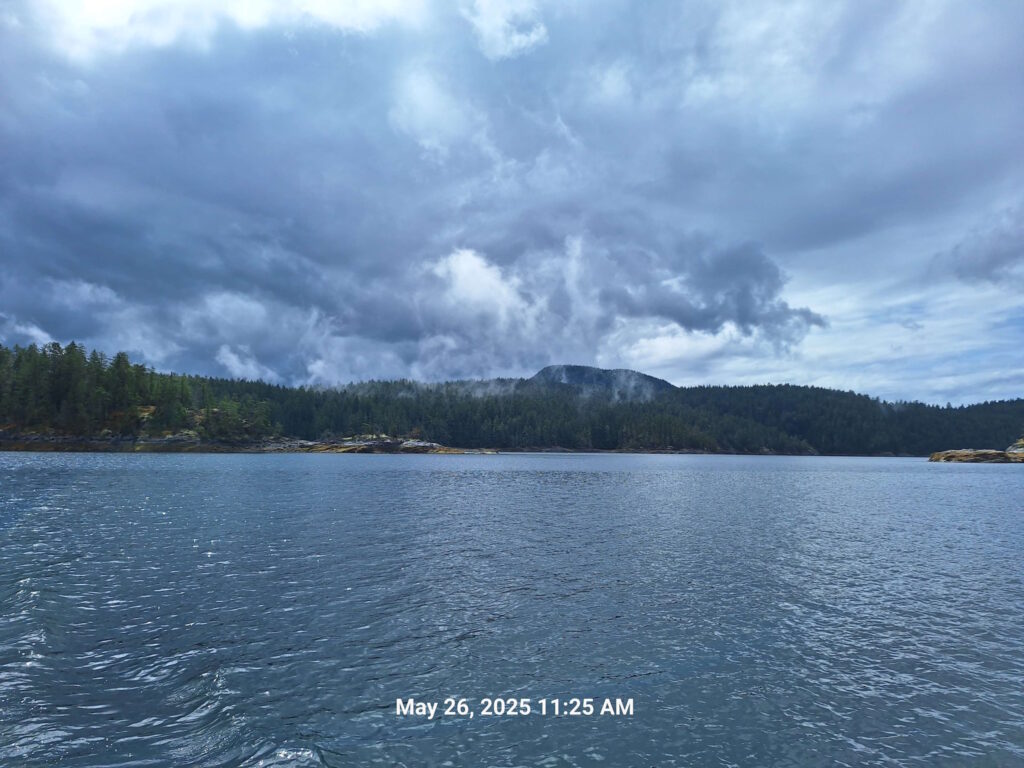
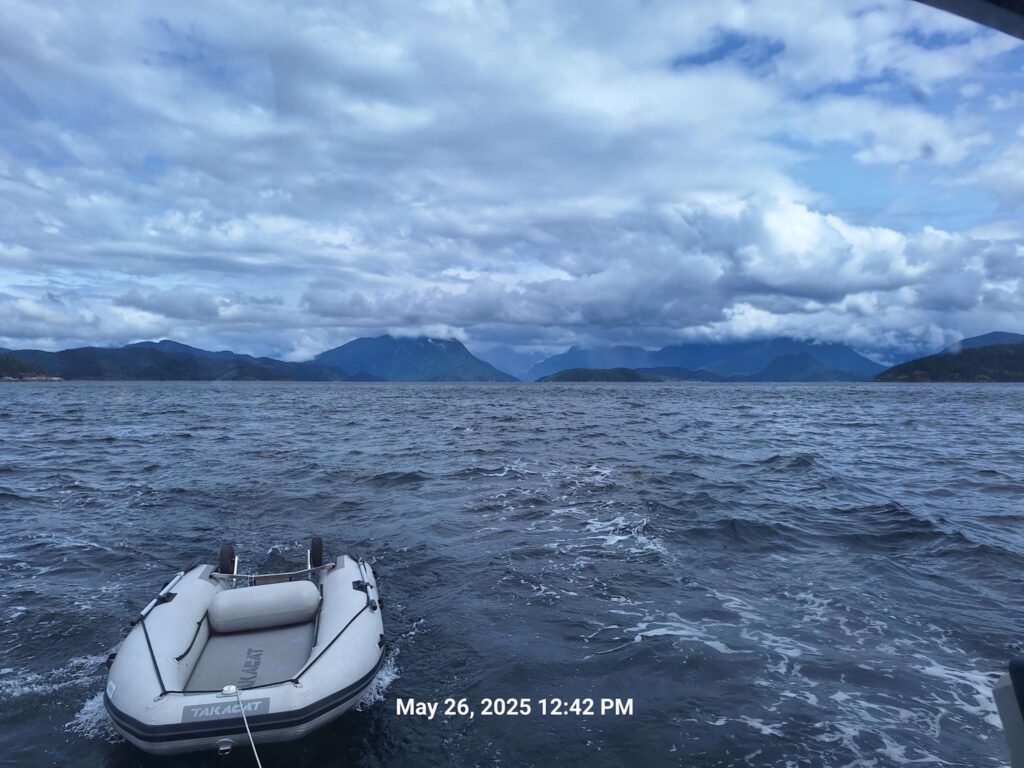
Lund
On Monday morning it was raining in sheets until about 10am. Rain had been in the weather prediction, but this amount of rain was a bit surprising since we’d had such mild weather recently. Very little wind accompanied it, though, and we left around 11am, with the tentative destination of Comox. Whether we went to Comox or not really depended on when the riggers would be able to come to the boat, and since we still didn’t have reliable enough signal to make a call (though we were occasionally, depending on our swing in the bay, getting snippets of 5G enough to get emails and updates on various discord servers), we wouldn’t know until I was able to call them.
About an hour in we had good phone signal again and I was able to get ahold of them: Wednesday would be the day. Thus, there was no need to go all the way to Comox that day. This turned out to be very good, since shortly after the call the winds began building from 15… 17… 20… 23 knots. We figured we could go to either Lund or further down to Powell River, and made the decision to go to Lund, taking the protected-from-waves-at-least Thulin Passage between the mainland and the Copeland Islands, a group of small, rocky and forested islands that make up Copeland Islands Marine Provincial Park, where there are several camping areas (primarily for kayakers, I think) and some very small anchorages with stern tie chains, though none seemed like a place I would want to maneuver Kestrel into, and certainly not with the buffeting (and slowing) we were getting from often over 20 knots of wind directly into our faces. The protection from the waves seemed worth it though, because the conditions inside the channel were just mildly choppy. I don’t know what the conditions out on the open Strait of Georgia were but given our experience a week before, I imagined that it would be quite uncomfortable.
Lund is a cute little community largely centered around fishing, and the resort marina that we stayed at for the night. There is no anchoring at all in the Lund area, and the marina is also the deepest I’ve ever been in; where we were docked my sonar showed over 70 feet under us!
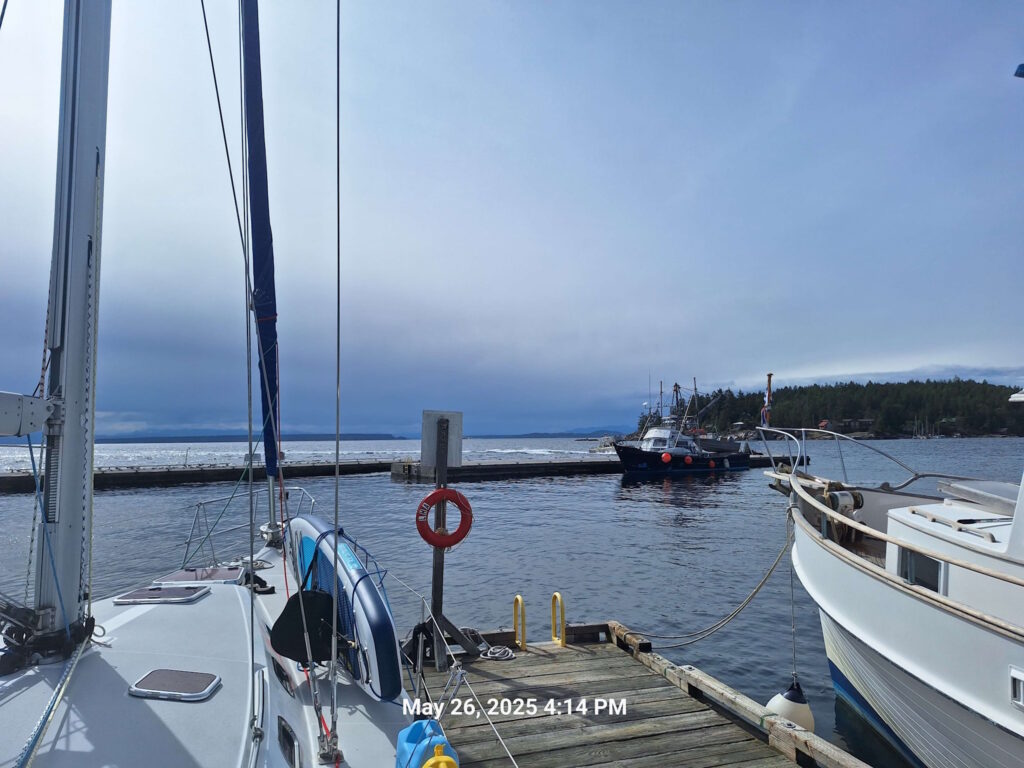
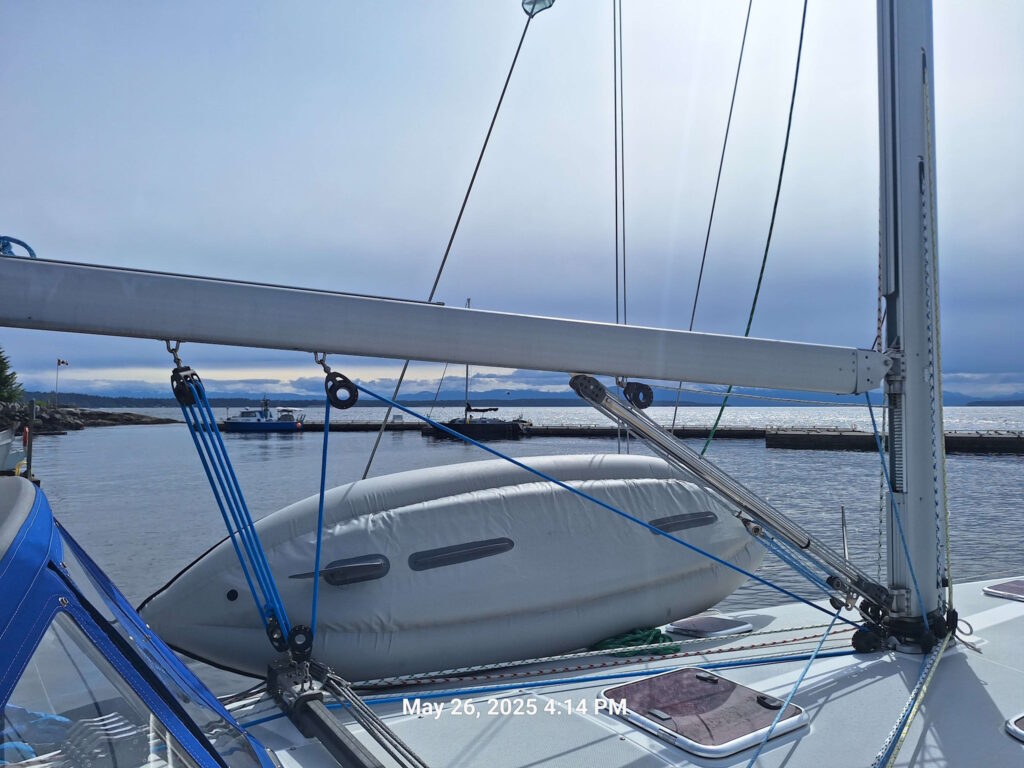
I haven’t yet mentioned the noise. Not from Lund, from our mast. One thing I have learned during my over three years of owning Kestrel is that if there is no sail in the mast, the long, flexible aluminum part that the sail slots into and rotates around, will bang around inside the mast and make a terrible racket. I didn’t know this until I’d taken the original main out a few weeks before the new one was delivered; a terrible idea, in hindsight. This time it was unavoidable, and while it banged around while we were moving, it was tolerable, especially with all the motoring. In all the anchorages we’d been in between Comox and Lund, it wasn’t a problem either, because of how calm they were.
The marina in Lund was not perfectly calm, and our mast banged. And clanged. And did. Not. Stop. All night. Keep in mind that our bed… our heads… my head… right next to the mast. Thus began one of the worst nights we’ve had on Kestrel. It wasn’t the motion of the boat at all; that was minimal and comfortable. It was the clanging. At first, we tried to grit it out, then put noise-canceling headphones on, then partway through the night added earplugs under the noise-canceling headphones. I’m very, very sorry to the two boats next to us, but they have no idea how bad we had it.
At least Nancy’s Bakery was good. I loved the blackberry cinnamon roll, and my partner enjoyed the pecan version just as much, as well as the Quebecois meat pie for lunch (which she also really enjoyed).
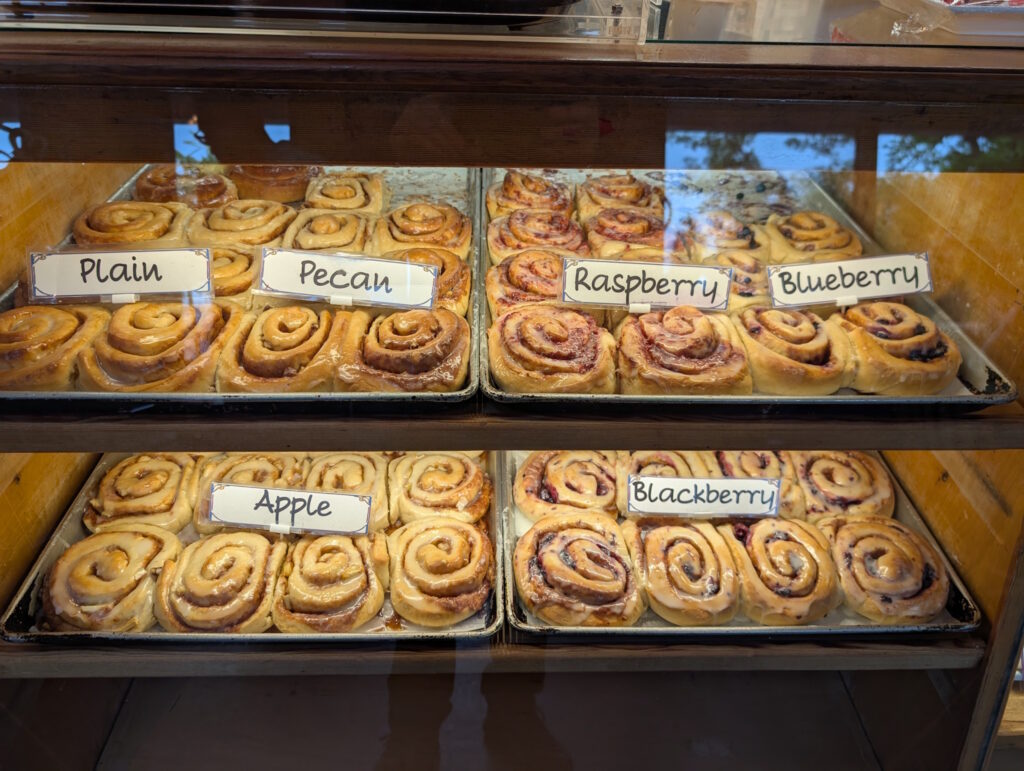
Back to Comox
What started out as a windy morning that, after we got past Mystery Reef (yes, really, that’s the name) on the southeast side of Savary Island, we were able to motorsail on for an hour and a half, turned into a very calm day on the Strait of Georgia. Taking one and a half hour shifts, my partner and I just followed the waypoints I’d set up while keeping watch ahead of us, while the other person dozed or listened to music on the cushions of the cockpit away from the mast!
Getting into the protected bay at Comox was wonderful: the clanging finally stopped. An easy, calm docking with next-to-no wind, and we’re back into this lovely little town. Tomorrow the riggers arrive, but for now, I’m sitting in the Blackfin Pub writing this and about to order a pizza from Boonies Pizza, which we ordered from the previous week and loved. Much like True Love Pizza in Ganges, Boonies does wonderful sourdough pizza dough.
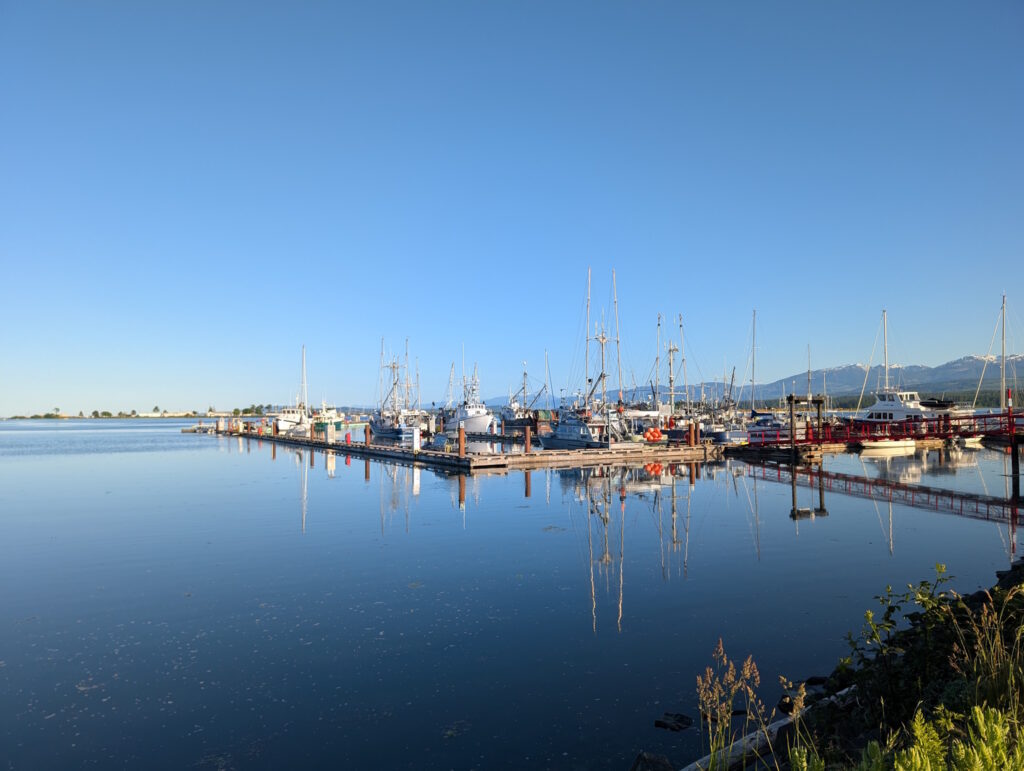
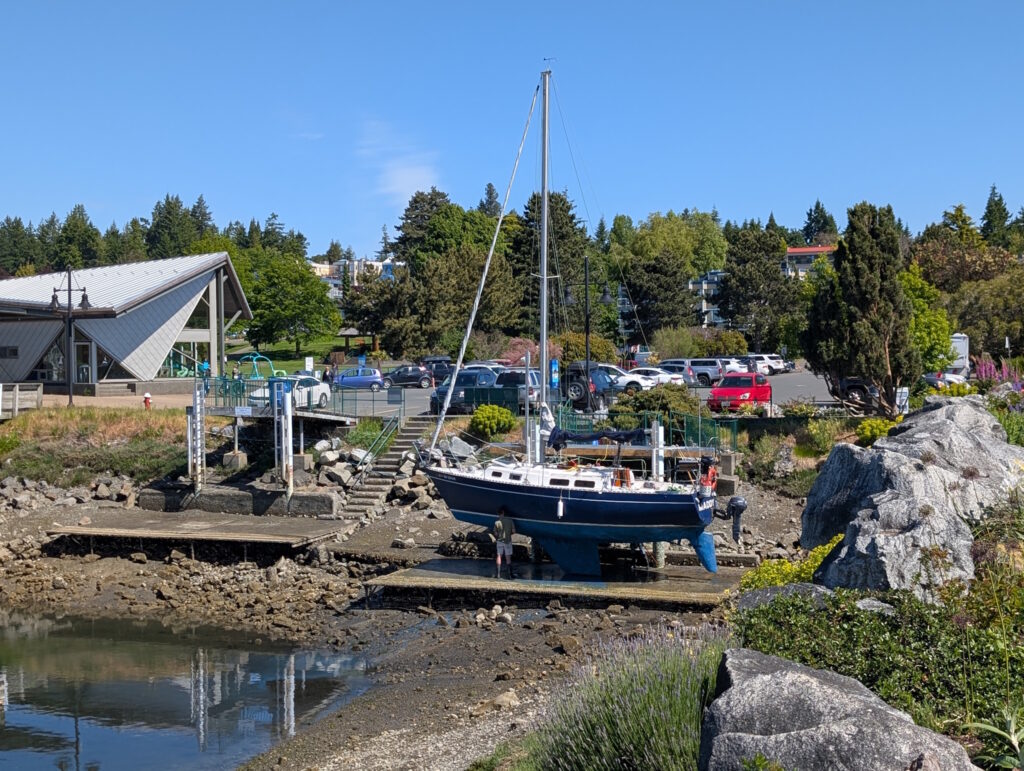
Whew. I need to make these blog updates more often, but these last two weeks have been, with a few weather-related exceptions, extremely chill. On the Thursday the 29th we head back out towards Desolation Sound until the riggers are ready for us sometime next week! We’ll probably head to Squirrel Cove or Refuge Cove first.

I enjoyed reading this!